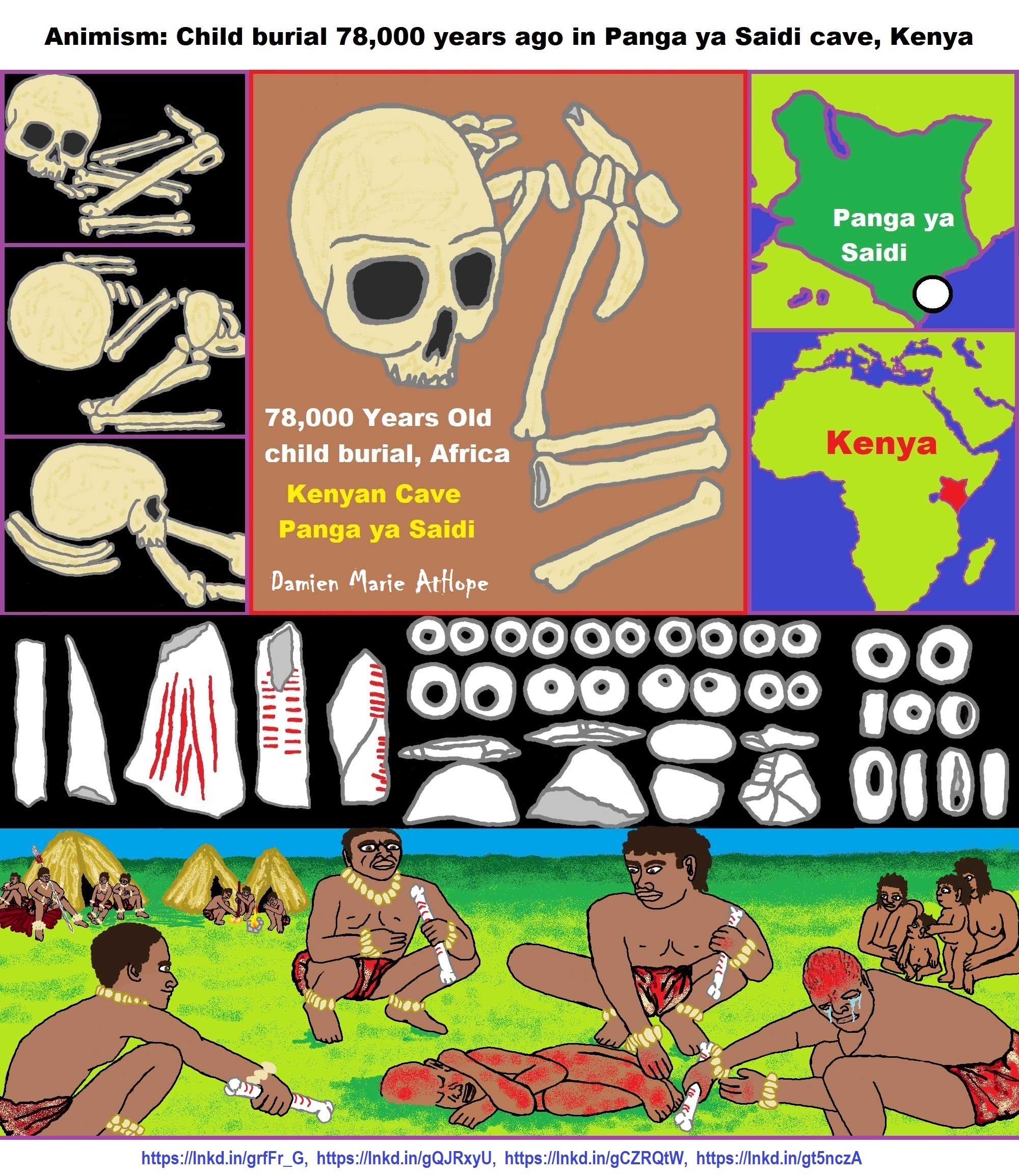
78,000 Years Ago
“Mtoto’s burial, to experts it is believed the child was around three years old when they died and was likely wrapped in a shroud and had their head on a pillow. Besides the seemingly deliberate position of the body, the team noticed a few clues that suggested the child was swaddled in cloth, possibly with the intention of preserving the corpse. They also speculate the body was placed in a cave fissure — known as funerary caching — before being covered with sediment.” ref, ref

Pic ref
Scientists find Africa’s oldest human burial, a child from 78,000 years ago
“The discovery of a deliberately buried toddler may offer new insights into the Middle Stone Age, a key period in the human timeline. A cluster of 78,000-year-old bones found at the mouth of a Kenyan cave represents the earliest known human burial in Africa, shedding light on how our ancient ancestors interacted with the dead. The remains belong to a Middle Stone Age child believed to have been between 2.5 and 3 years old. The bones of the toddler, whom scientists nicknamed Mtoto (“child” in Swahili), come from the Panga ya Saidi cave complex in coastal southeast Kenya. The excavation site has yielded a rich trove of historical artifacts, including beads made from seashells and thousands of tools that reflect technological shifts from the Middle Stone Age to the Later Stone Age.” ref
“When archaeologists found Mototo’s highly decomposed remains, they couldn’t immediately identify them as human. In a study published Wednesday in the journal Nature, researchers from Germany’s Max Planck Institute for the Science of Human History and the National Museums of Kenya detail how they came to conclude, through microscopic analysis of the bones and the surrounding soil, that the skeleton in a cave’s shallow circular pit belonged to a child who’d intentionally been laid to rest.” ref
“Deliberate burial of the dead is so far confined to just Homo sapiens and Neanderthals, setting us apart from all other ancient hominins, and any other animal,” Nicole Boivin, an archaeological scientist, and director of the Max Planck Institute for the Science of Human History, tells me. “Study of mortuary and burial practices gives us insight into the evolution of our own species, our thoughts, emotions and cosmological beliefs, and what it means to be human.” ref
“Earlier hominins also treated the dead in special ways. For example, the archaic human species Homo Naledi appears to have placed bodies in the back of South Africa’s Rising Star Cave about 300,000 years ago. That’s a practice referred to as funerary caching. Mtoto’s case, in contrast, demonstrates a more complex process through evidence of a purposefully excavated pit followed by an intentional covering of the corpse. The child appears to have been prepared for a tightly shrouded burial, placed on one side with knees drawn toward the chest. Even more notable is that the position of the child’s head suggests it rested on some sort of support, like a pillow. That indicates the community may have performed a mourning rite.” ref
The archaeologists first came upon parts of the bones in 2013, and four years later, discovered the burial pit about 10 feet (3 meters) under the cave floor. “At this point, we weren’t sure what we had found,” says Emmanuel Ndiema of the National Museums of Kenya. “The bones were just too delicate to study in the field. So we had a find that we were pretty excited about, but it would be a while before we understood its importance.” ref
“Once they made plaster casts of the remains they brought those to the National Research Center on Human Evolution in Burgos, Spain, for further study. It was there the team started uncovering parts of the skull and face, which still had some unerupted teeth in place. “The articulation of the spine and the ribs was also astonishingly preserved, even conserving the curvature of the thorax cage, suggesting that it was an undisturbed burial and that the decomposition of the body took place right in the pit where the bones were found,” says professor María Martinón-Torres, director of the center.” ref
“The origin and evolution of human mortuary practices are subjects of intense interest and debate, as they can help reconstruct the past by illuminating details on cognition, migration, social strata, disease, religion, and more. Evidence of burials of both Neanderthals and modern humans in Eurasia date back earlier in the Middle Stone Age, to as far as 120,000 years ago. But evidence of burials in Africa have been scarce, and hard to attach exact dates to.” ref
“It is great to have such a well-dated example of a modern human from Africa being buried,” says Professor Andy Herries, head of archaeology at Australia’s La Trobe University, who isn’t affiliated with the Nature study. “I think, however, that the find, while being very important, perhaps raises more questions than it answers.” ref
“Questions, for example, about whether humans of the time buried one another according to specific rituals or whether our earliest ancestors thought about death and the afterlife the same way we do today. Still, for anyone interested in human evolution, it’s an exciting discovery — both for what it could teach us about our forebears and the way it unfolded layer by sedimentary layer.” ref
“Herries calls Panga ya Saidi one of the most significant archaeological sites in the world. Archaeologists, geologists, earth scientists, paleoecologists, and biological anthropologists plan to continue excavating the cave complex for more insights into the world of Mtoto, Mtoto’s ancestors, and the people who followed.” ref
(Reuters) – “It is a scene that exudes sadness: a child perhaps 2-1/2 or 3 years old buried in a shallow grave under the sheltered overhang of a cave, head resting on a pillow and the upper part of the body carefully wrapped in a shroud.”
- Kenyan Cave Provides New Insights into Later Stone Age
- Child’s burial 78,000 years ago in Kenya was a Homo sapiens milestone
- Scientists unearth Africa’s oldest burial: a small child, laid to rest 78,000 years ago
Panga ya Saidi
“Panga ya Saidi is an archaeological cave site located in Kilifi County, southeastern Kenya, about 15 km from the Indian Ocean in the Dzitsoni limestone hills. The cave site has rich archaeological deposits dating to the Middle Stone Age, Later Stone Age, and Iron Age. Excavated deposits preserve an unusually long record of human activities, from around 78,000 years ago until around 400 years ago, a chronology supported by radiocarbon dating and optically stimulated luminescence dating. This sequence puts Panga ya Saidi alongside other key sites such as Enkapune ya Muto, Mumba Rockshelter, and Nasera Rockshelter that are important for understanding the Late Pleistocene and the Middle to Later Stone Age transition in eastern Africa.” ref
“The archaeological potential of Panga ya Saidi was first noted by Robert Soper and later by Richard Helm. Beginning in 2010, the cave site has been excavated by the Sealinks Project, headed by Nicole Boivin. The interdisciplinary archaeological project now based at the Max Planck Institute for the Science of Human History, in partnership with the National Museums of Kenya. These investigations have helped to establish the significance of Panga ya Saidi for understanding the Middle to Later Stone Age technological transition and the proliferation of symbolic objects such as bone tools, engraved ochre, and beads in Late Pleistocene eastern Africa. ” ref
“Zooarchaeology and stable isotope analysis have been used to reconstruct Late Pleistocene and Holocene paleoecology and subsistence from animal bone remains. Investigations have also focused on the role of the site in late Holocene agricultural and trading networks along the Swahili coast, with African crops such as pearl millet, nonnative animals such as black rat, marine shell beads, glass beads, and Tana ware pottery documented in the Iron Age deposits. Ancient DNA recovered from a 400-year-old burial indicated that this individual was most closely related to ancient and present-day hunter-gatherers in eastern Africa, including the ancient individual at Mota, Ethiopia.” ref
“The site is located in Southern Kenya’s Nyali Coast region. This area includes the counties of Kilifi, Mombasa, Kwale. This region includes the limestone Dzitsoni Uplands. Thirteen rivers extend across the area, creating floodplains and alluvial valleys. The site’s environmental surroundings are part of an overall transition from low coastal plains to coastal uplands to high coastal plains. In the northern part of the region, the low and high coastal plains are separated by a foot plateau. The southern part of the region differs in that the low and high coastal plains are instead divided by a coastal range. This coastal range is defined by steep hills and erosional scarps. In terms of vegetation, the site is situated on the edge of the Arabuko Sokoke Forest, is overlooking the Shale Savannah, and is west of the Lowland Dry Forest on Coral Rag and the Mangrove Thicket on the low coastal plains. The region experiences two rainy seasons. The first short rainy season spans from October to December, and is followed by a long rainy season spanning from April to June.” ref
“Based on a 3-meter deep excavation of the archaeological site, a sequence of 19 layers were found and divided by three lithographic boundaries into four groups. The oldest group consisted of Layers 19 – 17 (dated to 76,000-73,000 years ago) characterized primarily by reddish-brown clay loams with bone fragments from mollusk shells and mammals, and appears to lack any structures. The unit is interpreted as a period of sporadic human occupation. Layers 16 – 14 (67,000-59,000 years ago) consisted mostly of orange-brown slit-like loam with deposits of ash and bedrock clasts. There is an increased presence of human activity with lithics, bone fragments, and charcoal flakes appearing in Layers 15 & 14. Unit II is interpreted as a floor level, with accumulated wall and roof collapses and evidence of burning.” ref
“Unit III with layers 13 – 5 (59,000-14,000 years ago) contains heterogenous loam with abundant evidence of human activity and ash, with the presence of hearths, burning, lithics, and floor hollows. The Layer 13/12 boundary at about 51,000 years ago reflects a hiatus between two different occupational phases. The increase of human activity is shown by the concentration of human-occupation byproducts, however, occupation is intermittent. Finally, Unit IV, or layers 4 -1 (8000 years ago to 400 years ago), consists of loose and silty loam with deposits of charcoal, bone fragments, marine shells, and lithics. The layers are disturbed, with degradation of the cave walls and floor reflecting intermittent human occupation (including a burial and hearths).” ref
Stone tools
“Lithic technology, or stone tools, form an important part of the Panga ya Saidi archaeological record and have helped archaeologists to understand the Middle Stone Age to Later Stone Age transition at the site. The main raw materials used are quartz, followed by chert, and in rare cases, limestone. Limestone was used for informal knapping techniques. Quartz was preferentially used for bipolar flaking of small cores. More formal tool preparation (to make Levallois tools or prismatic blades) was preferentially done on chert. Chert also more frequently underwent reduction, suggesting it was highly valued and conserved, which may suggest it was relatively more difficult to obtain.” ref
“There are important changes over time in the lithic technology sequence at Panga ya Saidi. Large or medium-sized tools made on coarse-grained raw material including limestone, using the Levallois technique, are found in early deposits at the site. These Levallois cores, flakes, and retouched flakes are typical of the Middle Stone Age in eastern Africa. Between 72,000-67,000 years ago, archaeologists note a trend over time toward bipolar reduction techniques and smaller and sharper tools, such as prismatic blades, made on fine-grained raw material. Limestone becomes rare, and quartz common. The shift toward smaller tools, a phenomenon known as miniaturization, as well as shifts toward more frequent bipolar reduction and blade technology, are all typical features of the Later Stone Age in eastern Africa. Over time, other forms, such as crescents, also become more common.” ref
“However, the archaeologists note that this is not a dramatic transition, since Levallois techniques continue to be used throughout much of the Panga ya Saidi sequence, even after new technologies appear. This suggests that the Middle to Later Stone Age transition cannot be described in simplistic terms or as a single package. The archaeologists conclude that the defining feature of this transition at Panga ya Saidi is miniaturization, rather than specific tool types or reduction techniques.” ref
Faunal remains
“Mostly small bovids (like duiker and suni), suids (warthog and bushpig), and some primates were found in the faunal remains as the basis of subsistence, while marine faunal remains are understood to be mostly utilized symbolically in the material culture (such as marine shell beads) until the Holocene, when they were also used for consumption.” ref
Tropical environments like those found in coastal eastern Africa were deemed to be a sort of refugium for early human populations, due to their comparatively stable environment and the abundance of edible fauna from the exploitation of the closed forests, woodland, and grassland environments. Zooarchaeology and stable isotope analysis show the environments around Panga ya Saidi changed slightly over time. In the earlier layers of the sequence, skeletal remains of small primates and small bovids living in a closed habitat were relatively common.” ref
This initially humid forested area transitioned toward a higher concentration of grassland and a decrease in the forested area during Marine Isotope Stage (MIS) 3, as seen by an increase in skeletal remains of larger grazing bovids. This was followed by a resurgence in humid, forested land at the Pleistocene to Holocene transition, when small bovids become more common again in the faunal remains. Carbon and oxygen stable isotope analysis concur with the zooarchaeological evidence, indicating that there were shifts from more wooded ecosystems in the MIS 5 and MIS 4 to open habitats in MIS 3 and a later shift back into wooded, grassland environments in the Holocene. Roberts et al. concluded from their evidence that this heterogeneous environment allowed Homo sapiens to develop novel technologies and material culture.” ref
Human remains
“A deciduous second molar of a child was found in some of the deepest deposits at Panga ya Saidi, located in Layer 18 and dating to about 78,000 years ago (MIS 5). Carbon and oxygen stable isotope analysis indicates reliance on C3 plants. Since this is a deciduous tooth, that dietary signal may reflect the diet of the child’s mother if breastfeeding, or it may reflect foods given to the child if weaning. The signal of C3 plants is consistent with zooarchaeological evidence showing that the main animals at Panga ya Saidi in the deepest layers were from tropical forested or woodland environments.” ref
“Evidence of modern behavior was found in 2021 when evidence of Africa’s earliest intentional burial was found. A 78,000-year-old Middle Stone Age grave of a three-year-old child was discovered in Panga ya Saidi cave. Researchers said the child’s head appeared to have been laid on a pillow. The body had been laid in a fetal position. However, this alleged burial is tens of thousands of years younger than burials at Skhul and Qafzeh cave, in Israel who belonged to African populations with the same African lithic cultural tradition.” ref
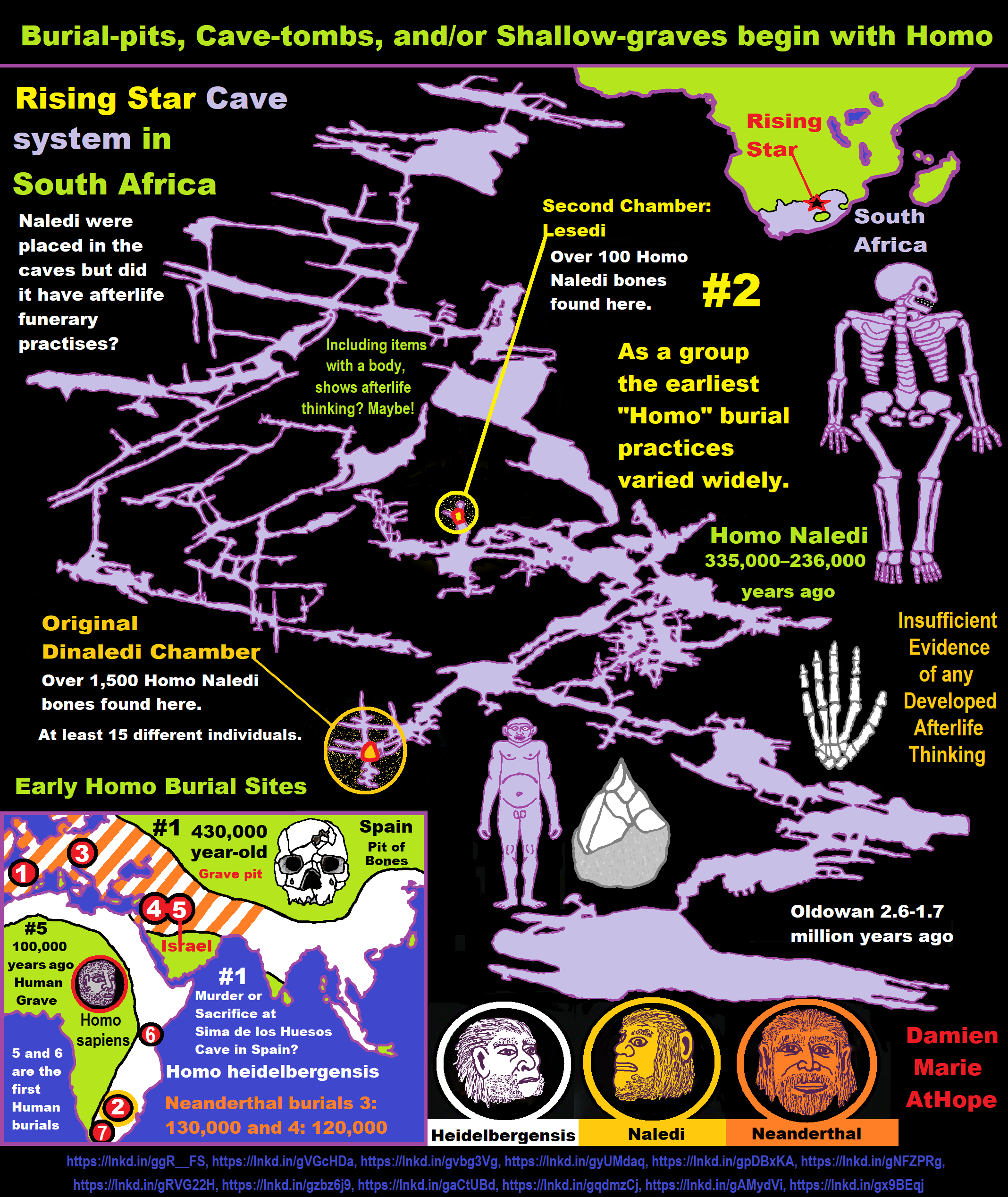
ref, ref, ref, ref, ref, ref ,ref ,ref ,ref ,ref, ref, ref
Burial-pits, Cave-tombs, and/or Shallow-Shallow-graves begin with Homo: LINK
Homo Naledi
“Homo Naledi is a species of archaic human discovered in the Rising Star Cave, Cradle of Humankind, South Africa dating to the Middle Pleistocene 335,000–236,000 years ago. The initial discovery comprises 1,550 specimens, representing 737 different elements, and at least 15 different individuals. Despite this exceptionally high number of specimens, their classification with other Homo remains unclear.” ref
“Along with similarities to contemporary Homo, they share several characteristics with the ancestral Australopithecus and early Homo as well (mosaic anatomy), most notably a small cranial capacity of 465–610 cm3 (28.4–37.2 cu in), compared to 1,270–1,330 cm3 (78–81 cu in) in modern humans. They are estimated to have averaged 143.6 cm (4 ft 9 in) in height and 39.7 kg (88 lb) in weight, yielding a small encephalization quotient of 4.5. Nonetheless, Homo Naledi’s brain anatomy seems to have been similar to contemporary Homo, which could indicate equatable cognitive complexity. The persistence of small-brained humans for so long in the midst of bigger-brained contemporaries revises the previous conception that a larger brain would necessarily lead to an evolutionary advantage, and their mosaic anatomy greatly expands the known range of variation for the genus.” ref
“Homo Naledi anatomy indicates that, though they were capable of long-distance travel with a humanlike stride and gait, they were more arboreal than other Homo, better adapted to climbing and suspensory behavior in trees than endurance running. Tooth anatomy suggests consumption of gritty foods covered in particulates such as dust or dirt. Though they have not been associated with stone tools or any indication of material culture, they appear to have been dextrous enough to produce and handle tools, and likely manufactured Early or Middle Stone Age industries. It has also been controversially postulated that these individuals were given funerary rites, and were carried into and placed in the chamber.” ref
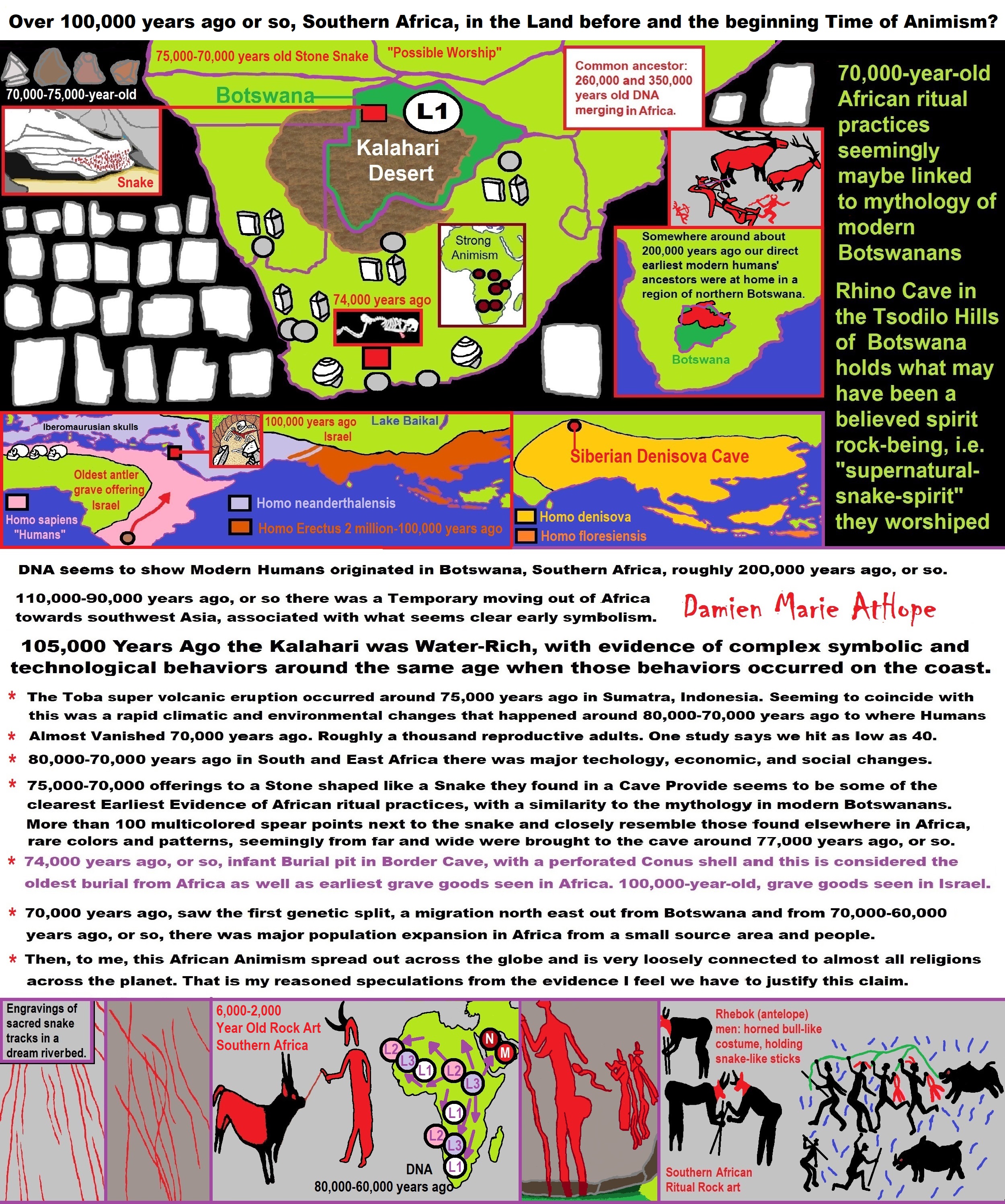
ref, ref, ref, ref, ref, ref, ref, ref, ref, ref, ref, ref, ref, ref, ref, ref, ref, ref, ref, ref, ref, ref, ref, ref, ref, ref, ref, ref, ref, ref, ref, ref, ref, ref, ref, ref, ref, ref, ref, ref, ref, ref, ref, ref, ref, ref, ref, ref, ref, ref, ref, ref, ref
Animism: a belief among some indigenous people, young children, or all religious people!
Over 100,000 years ago or so, Southern Africa, in the Land before and the beginning Time of Animism: LINK

ref, ref, ref, ref, ref, ref, ref, ref, ref, ref, ref, ref, ref, ref, ref, ref, ref, ref, ref, ref, ref, ref, ref, ref, ref, ref, ref, ref, ref, ref, ref, ref, ref, ref, ref, ref, ref, ref, ref, ref, ref, ref, ref, ref, ref, ref, ref, ref, ref, ref, ref, ref, ref, ref, ref, ref, ref, ref, ref, ref, ref, ref
Explaining the Earliest Religious Expression, that of Animism (beginning 100,000 to 70,000 years ago?) to Totemism (beginning 30,000 to 3,000 years ago?) in Southern Africa: LINK

430,000 years ago, Sima de los Huesos, “Pit of Bones”, Atapuerca, Spain, seeming evidence of intentional storing of 28 individuals in a cave chamber pit (a symbolic pseudo-womb?) and a reddish quartzite tool found with the bodies, seems like a kind of ritual funeral offering in this possibly early cemetery. Fossil remains of 430,000-400,000-years-old 28 individuals, 6,500 bone fragments, and 500 teeth, in one of several important sections of the Cueva Mayor-Cueva del Silo cave system in north-central Spain. The bone pit is at the bottom of the cave, beneath an abrupt vertical shaft measuring between 6.5-13 feet in diameter, and located about .1/3 of a mile in down a 42.5 ft shaft and it is possibly an expression of mortuary practices. ref
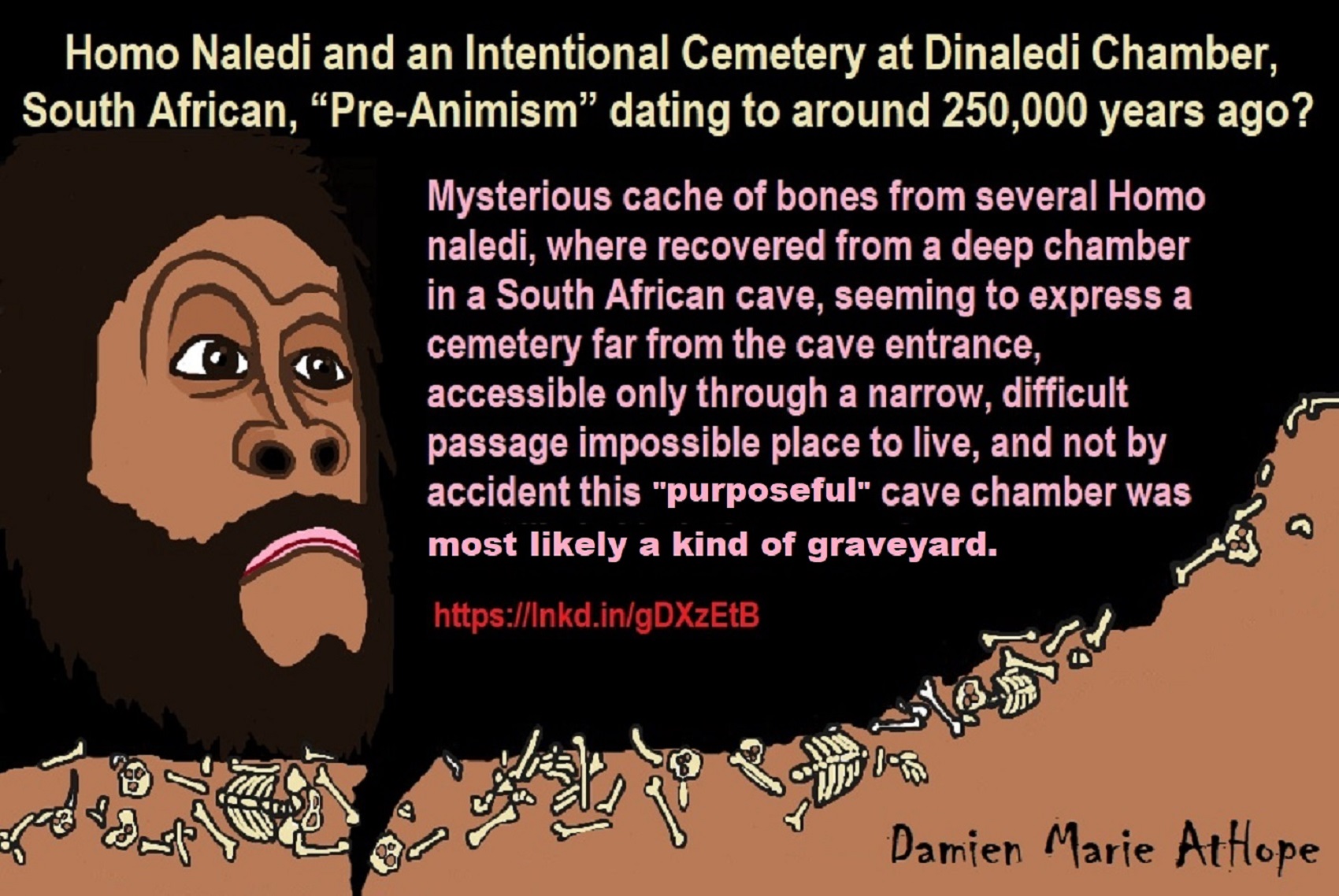
Homo Naledi and an Intentional Cemetery “Pre-Animism” dating to around 250,000 years ago?
To me, it seems likely Homo Naledi did have an intentional cemetery as seen at Dinaledi Chamber, in South Africa, thus “Pre-Animism” dating to around 250,000 years ago. The odd cache of bones from several Homo Naledi were recovered from a deep chamber in a South African cave, seeming to express a cemetery far from the cave entrance, accessible only through a narrow, difficult passage impossible place to live, and not by accident this purposeful cave chamber was most likely kind of graveyard. ref
- The Evolution of Fire Sacralizing and/or Worship 1.5 million to 300,000 years ago and beyond?
- Stone Age Art: 500,000 – 233,000 Years Old
- Around 500,000 – 233,000 years ago, Oldest Anthropomorphic art (Pre-animism) is Related to Female
- 400,000 Years Old Sociocultural Evolution
- Pre-Animism: Portable Rock Art at least 300,000-year-old
- The Emergence of Pre-Religion 300,000 years ago, with Pre-Animism?
- Homo Naledi and an Intentional Cemetery “Pre-Animism” dating to around 250,000 years ago?
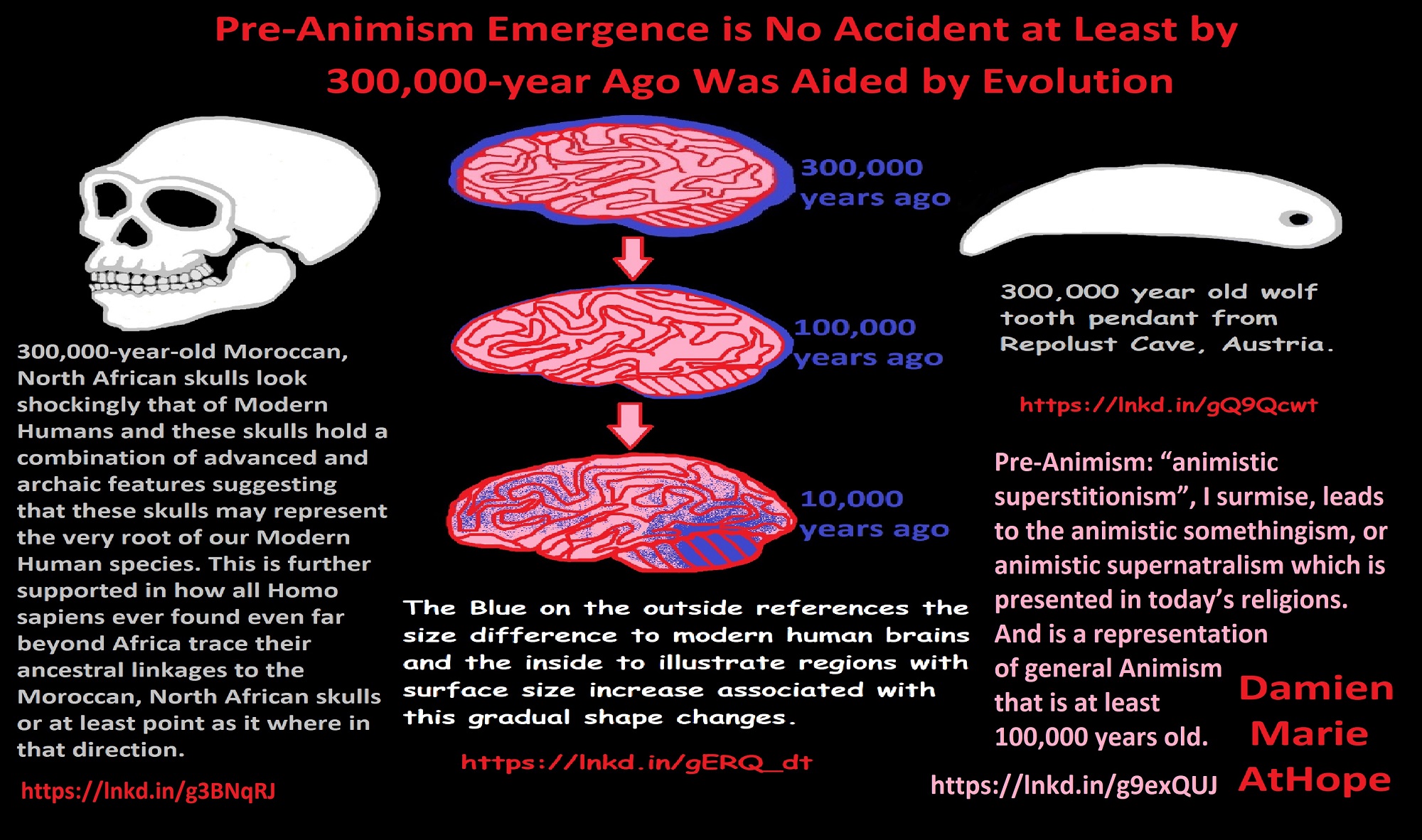
Pre-Animism Emergence is No Accident at Least by 300,000-year Ago Was Aided by Evolution
Pre-Animism: “animistic superstitionism”, I surmise, leads to the animistic somethingism, or animistic supernatralism is presented in today’s religions and is a representation of general Animism that is at least 100,000 years old. ref
The Blue on the outside references the size difference to modern human brains and the inside to illustrate regions with surface size increase associated with this gradual shape changes. ref
300,000-year-old Moroccan, North African skulls look shockingly that of Modern Humans and these skulls hold a combination of advanced and archaic features suggesting that these skulls may represent the very root of our Modern Human species. This is further supported in how all Homo sapiens ever found even far beyond Africa trace their ancestral linkages to the Moroccan, North African skulls or at least point as it where in that direction. And seemingly Homo sapiens could have been living across Africa and sem9ingly engaging in extensive movement, which could have involved exchange both in ideas, technology as well as even genetics. ref
300,000-year-old wolf tooth pendant from Repolust Cave, Austria. ref

Neanderthals “Primal Religion (Pre-Animism/Animism?)” Mystery Cave Rings 175,000 Years Ago
Neanderthals “Primal Religion (Pre-Animism/Animism?)”, Mystery Cave Rings 175,000 Years Ago, possibly a chapel or sacred space? Well, we do know it had meaning in some symbolic way, and they easily predate the arrival of modern humans in Europe. Thus, likely, they were built by Neanderthals, the only hominins in the region. The stalagmite structures are 50 centimeters high in places, says Jaubert. They are built from around 400 individual stalagmites with a combined weight of about 2 tons which must take time [to shift] and thus some time and effort to arrange the structures. ref
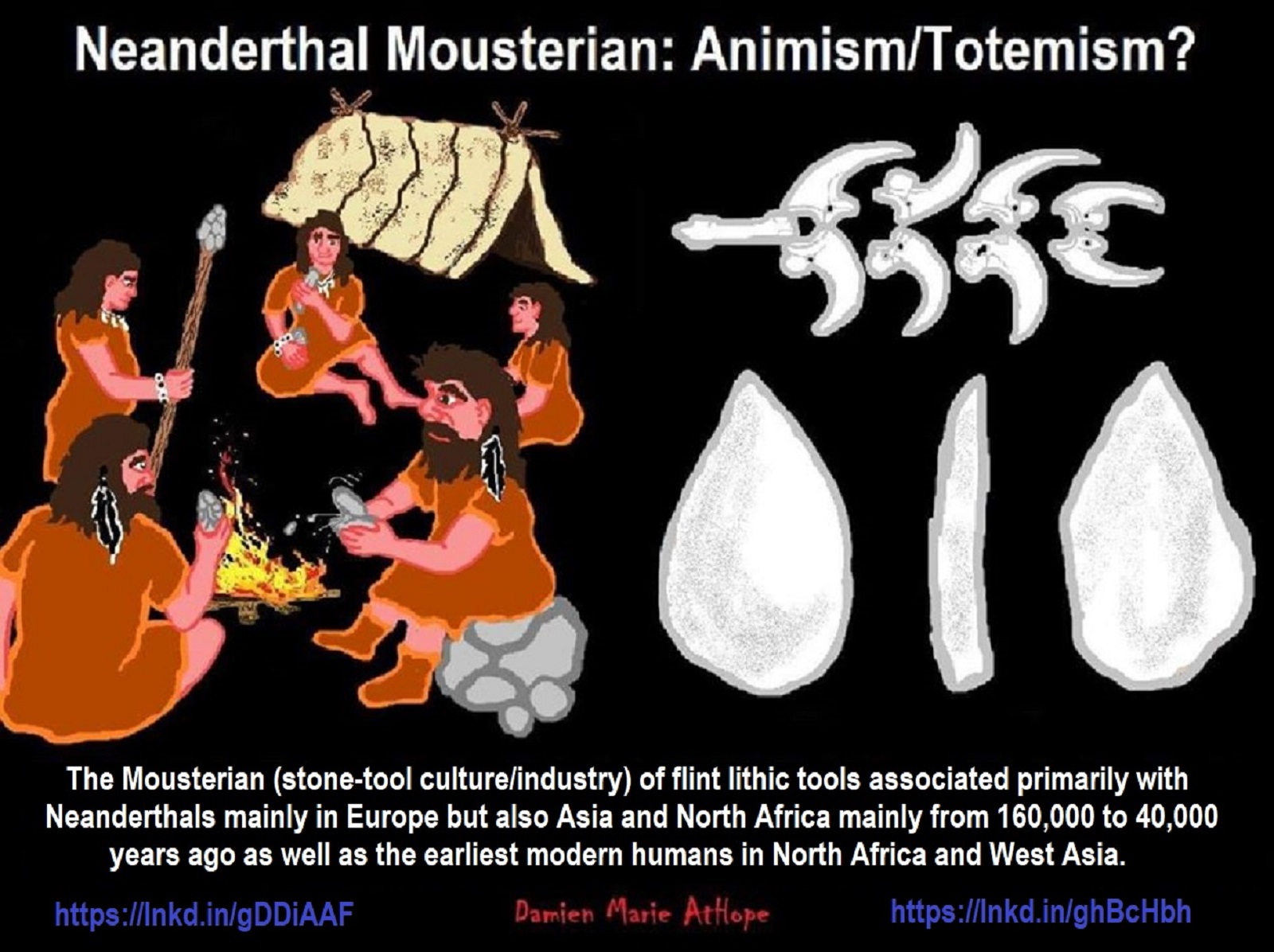
Neanderthal Mousterian: Animism/Totemism?
The Mousterian (stone-tool culture/industry) of flint lithic tools associated primarily with the earliest anatomically modern humans in North Africa and West Asia, as well as with the Neanderthals in Europe from 160,000 to 40,000 years ago. If its predecessor, known as Levallois or “Levallois-Mousterian” is included, the range is extended to as early as c. 300,000–200,000 years ago. Moreover, Mousterian continued alongside the new Neandertal Châtelperronian industry during the 45,000-40,000 ref

130,000 years ago – Earliest undisputed evidence for intentional burial and it is Neanderthals…
Evidence suggests that the Neanderthals were the first humans to intentionally bury the dead and possibly doing cannibalism which could be evidence of a death ritual, doing so in shallow graves along with stone tools and animal bones. 130,000 years ago – Earliest undisputed evidence for intentional burial. Neanderthals bury their dead at sites such as Krapina in Croatia. There was a total of 876 single Neanderthal fossil remnants found at the Hušnjak hill. The Bones belonged to several dozen different individuals, of different sex, from 2 to 40 years of age. Over a thousand pieces of various stone tools and weapons from the Paleolithic era were found, all witnessing to the material culture of the Krapina proto-human. This rich locality is approximately 130.000 years old.
Numerous fossil remnants of the cave bear, wolf, moose, large deer, warm climate rhinoceros, wild cattle, and many other animals were also found. Moreover, there is bird skeletons, with some of the parts modified, are found in association with the Neanderthal bones. Here are some talons and foot bones from the white-tailed eagle. There appears to be cut marks in the talons and foot bones to which they were attached, suggesting that Neanderthals were using the talons and bones as jewelry. This is supported by recent findings of gut “fiber” tied around part of a talon. Here are a foot bone and a talon that have been modified by having grooves cut in them. Neanderthals were largely carnivores, though we know they also used medicinal plants. ref, ref, ref
130,000 years ago – Earliest evidence for burial and it’s Neanderthals…
Did Neanderthals teach us “Primal Religion (Pre-Animism/Animism?)” 120,000 Years Ago?
Homo sapiens – is known to have reached the Levant between 120,000 and 90,000 years ago, but that exit from Africa evidently went extinct. Homo sapiens – is known to have reached the Levant between 120,000 and 90,000 years ago, but that exit from Africa evidently went extinct. Tabun Cave Mousterian (stone tool) culture (about 200,000 45,000 years ago). Small flint tools, made of thin flakes, predominate here, many produced by the Levallois technique. ref, ref

The Tabun Cave, Mount Carmel, Israel, occupied intermittently during the Lower and Middle Paleolithic (500,000 to around 40,000 years ago). Tabun suggests that ancestral humans used fire at the site on a regular basis since about 350,000 years ago and this likely would have shaped our culture and behavior. The material remains from the upper strata of the cave are of Levallois technique and the Mousterian culture (about 200,000 – 45,000 years ago). The Middle Palaeolithic of the southern Levant involved Neandertals and early modern humans, occupying the region at that time. Tabun Cave held fossil remains involved Neandertals and early modern humans but not an absolute chronology of the Levantine MP fossils though could indicates that an enamel fragment from the Tabun C1 could be as old as 143,000 years ago nearly double Tabun BC7. Moreover, a Neanderthal-type female, dated to about 120,000 years ago around the time early modern humans existed there which was between 120,000 – 90,000 years ago and again from 55,000 years ago on. ref, ref, ref, ref
Did Neanderthals teach us “Primal Religion (Pre-Animism/Animism?)” 120,000 Years Ago?
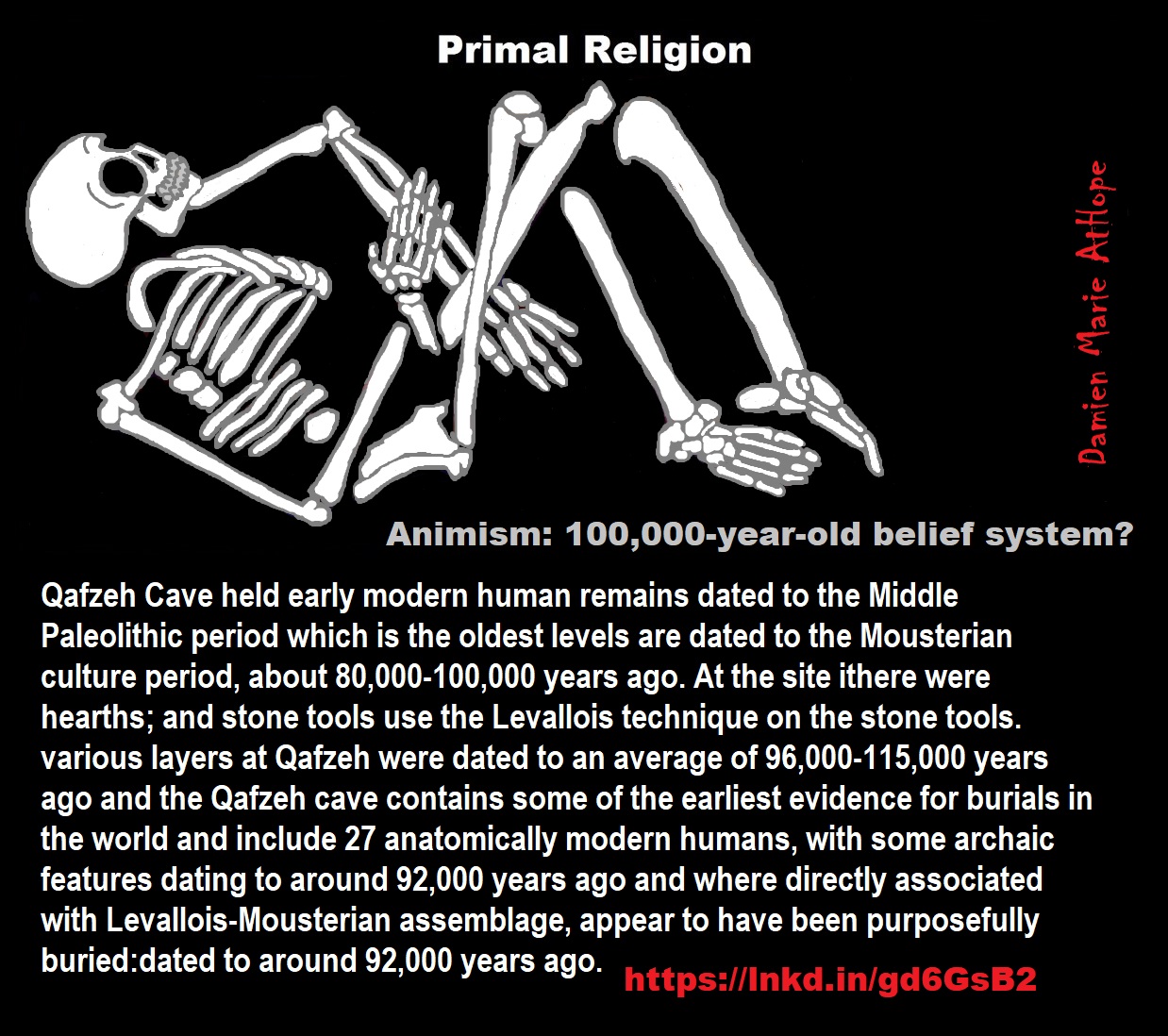
Animism: an approximately 100,000-year-old belief system?
Qafzeh Cave held early modern human remains dating to the Middle Paleolithic period which is the oldest levels are dated to the Mousterian culture period, about 80,000-100,000 years ago. At the site there were hearths; and stone tools use the Levallois technique on the stone tools. various layers at Qafzeh were dated to an average of 96,000-115,000 years ago and the Qafzeh cave contains some of the earliest evidence for burials in the world and included 27 anatomically modern humans, with some archaic features dating to around 92,000 years ago and were directly associated with Levallois-Mousterian assemblage, appear to have been purposefully buried: dated to around 92,000 years ago. The remains are from anatomically modern humans, with some archaic features; they are directly associated with Levallois-Mousterian assemblage. Modern behaviors indicated at the cave include the purposeful burials; the use of ochre for body painting; the presence of marine shells, used as ornamentation, and most interestingly, the survival and eventual ritual interment of a severely brain-damaged child. Moreover, deer antlers at Qafzeh 11 seem to be associated with burials unlike the marine shells which do not seem to be associated with burials, but rather are scattered more or less randomly throughout the site, possibly as a sacred offering, one that sanctifies an area? Or kind of blessing the aria? ref

At Border Cave, a “savanna-woodland” vegetation community is implied before 100,000 years ago and the matching density of stone tools vary considerably through time, with high frequencies of stone blades occurring before 100,000 years ago. ref
Around 74,000 years ago, in Border Cave, South Africa, the burial of a 4 to 6-month-old child was found in a pit with a personal ornament, a perforated Conus shell. ref
Border Cave is the only African site covering a time span of 250,000 years, with Middle Stone Age human remains, and also records the first emergence of key cultural innovations such as things like grass bedding dated between 70,000 to 30,000 years ago. ref
In South Africa, some of the oldest beads are made of marine shells that come from the Still Bay layers of Blombos Cave dating back to around 72,000 years ago, and engraved ostrich eggshells dated to around 60,000 years ago from Diepkloof in South Africa. Some of the oldest beads made of non-marine shells involve ostrich eggshells and from Border Cave, there are some that date to around 42,000 years ago. Beads were also collected from the late MSA/early LSA context of similar age at Apollo 11 and from layers associated with MSA at Boomplaas Cave. Furthermore, beads were also reported from the MSA at Cave of Hearths. Other sub-contemporaneous beads have been recovered north of South Africa. ref
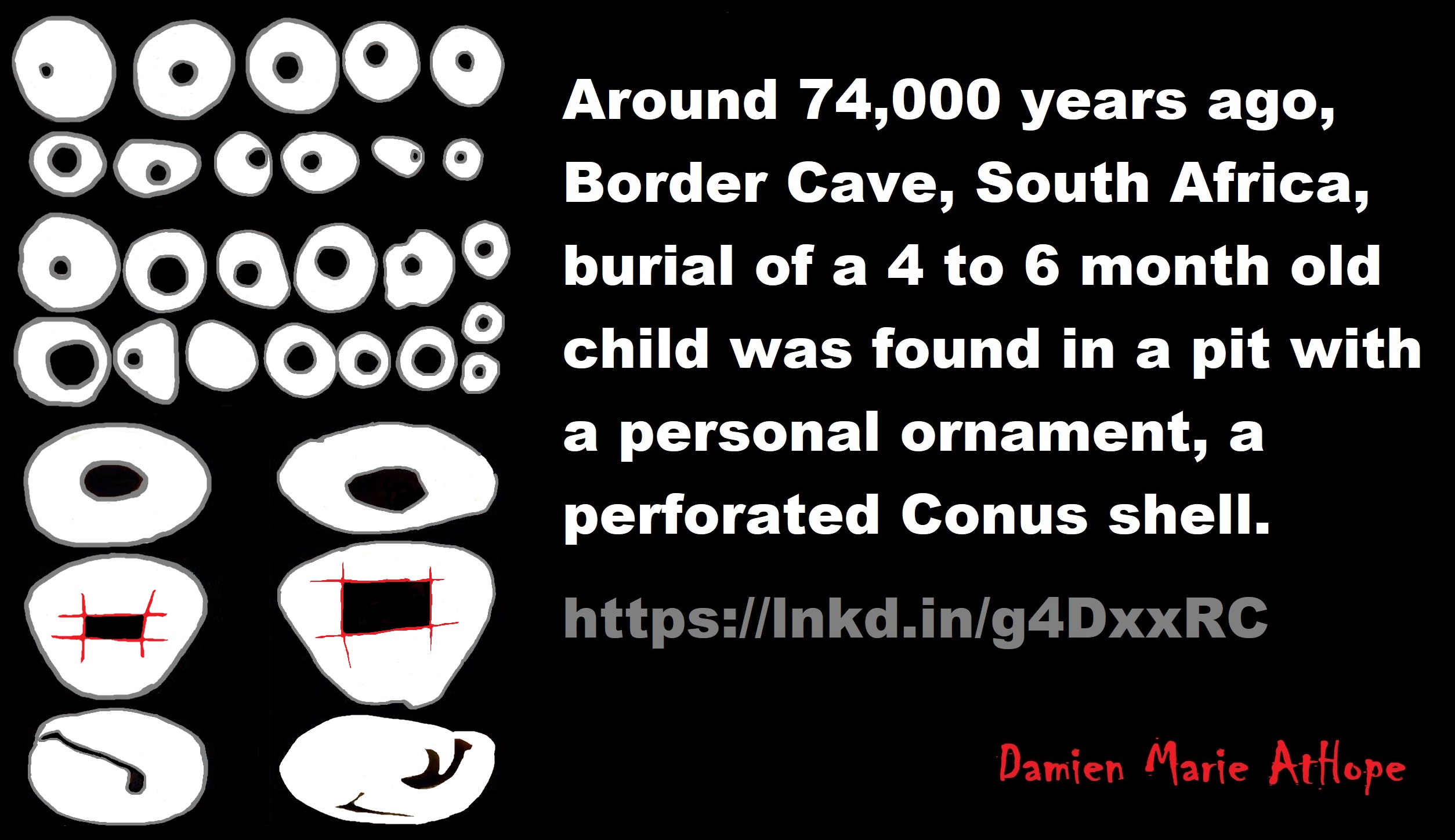
Was it Just Us, at Origin of Modern Mind 75,000 Years Ago?
It doesn’t look so, thus we need to rethink our ideas about the evolving mind of the Neanderthal skulls (right) are elongated from front to back like a football. Modern human adult has a basketball-like shape skulls (left) and Modern human infants also have somewhat elongated skulls, but by the time they reach adulthood, their heads have rounded out into a basketball-like shape. Analyzing Neanderthal DNA in Europeans identifies two Neanderthal gene variants linked to the head shape and also influence brain organization, in evolution acting on the brain might have reshaped the skull. Therefore, the Neanderthal DNA had a direct effect on brain shape and, presumably, brain function in humans today but infants start life with elongated skulls, somewhat like Neanderthals. ref
Evidence shows that Neanderthals had a complex culture although they did not behave in the same ways as the early modern humans who lived at the same time. Neanderthal dead were often buried, although there is no conclusive evidence for full ritualistic behavior, though at some sites, objects have been uncovered that may represent grave goods. ref

ref, ref, ref, ref, ref, ref, ref
Totemism is associated with kinship and the veneration of some natural objects, animals, plants, elements, and other physical objects, believed to have some spiritual or supernatural powers. So, harming of totemic animals is considered a taboo in most African cultures. Animism (‘breath, spirit, life’) belief objects, places, and nature may possess spiritual essence spirit.
Animism
“Animism (from Latin: anima, ‘breath, spirit, life‘) is the belief that objects, places, and creatures all possess a distinct spiritual essence. Potentially, animism perceives all things—animals, plants, rocks, rivers, weather systems, human handiwork, and perhaps even words—as animated and alive. Animism is used in the anthropology of religion as a term for the belief system of many indigenous peoples, especially in contrast to the relatively more recent development of organised religions. Although each culture has its own different mythologies and rituals, animism is said to describe the most common, foundational thread of indigenous peoples’ “spiritual” or “supernatural” perspectives. The animistic perspective is so widely held and inherent to most indigenous peoples that they often do not even have a word in their languages that corresponds to “animism” (or even “religion”); the term is an anthropological construct.” ref
“Aka people” Central African nomadic Mbenga pygmy people (Animist)
“Aka are very warm and hospitable. Relationships between men and women are extremely egalitarian. Men and women contribute equally to a household’s diet, either a husband or wife can initiate divorce, and violence against women is very rare. No cases of rape have been reported. The Aka are fiercely egalitarian and independent. No individual has the right to force or order another individual to perform an activity against his or her will. Aka have a number of informal methods for maintaining their egalitarianism. First, they practice “prestige avoidance”; no one draws attention to his or her own abilities. Individuals play down their achievements.” ref
Mbuti People of the Congo (Animist)
“The Mbuti hunter-gatherers in the Congo’s Ituri Forest have traditionally lived in stateless communities with gift economies and largely egalitarian gender relations. They were a people who had found in the forest something that made life more than just worth living, something that made it, with all its hardships and problems and tragedies, a wonderful thing full of joy and happiness and free of care. Pygmies, like the Inuit, minimize discrimination based upon sex and age differences. Adults of all genders make communal decisions at public assemblies. The Mbuti do not have a state, or chiefs or councils.” ref
Hadza people of East Africa (Animist)
“The Hadza of Tanzania in East Africa are egalitarian, meaning there are no real status differences between individuals. While the elderly receive slightly more respect, within groups of age and sex all individuals are equal, and compared to strictly stratified societies, women are considered fairly equal. This egalitarianism results in high levels of freedom and self-dependency. When conflict does arise, it may be resolved by one of the parties voluntarily moving to another camp. Ernst Fehr and Urs Fischbacher point out that the Hadza people “exhibit a considerable amount of altruistic punishment” to organize these tribes. The Hadza live in a communal setting and engage in cooperative child-rearing, where many individuals (both related and unrelated) provide high-quality care for children. Having no tribal or governing hierarchy, the Hadza trace descent bilaterally (through paternal and maternal lines), and almost all Hadza can trace some kin tie to all other Hadza people. ” ref
Hunter-Gatherer/Indigenous Peoples Religiosity, Beliefs, and Practices: LINK
I Support the World Following the Social Ways of the Animists in Africa as they have Beautiful Humanity: LINK
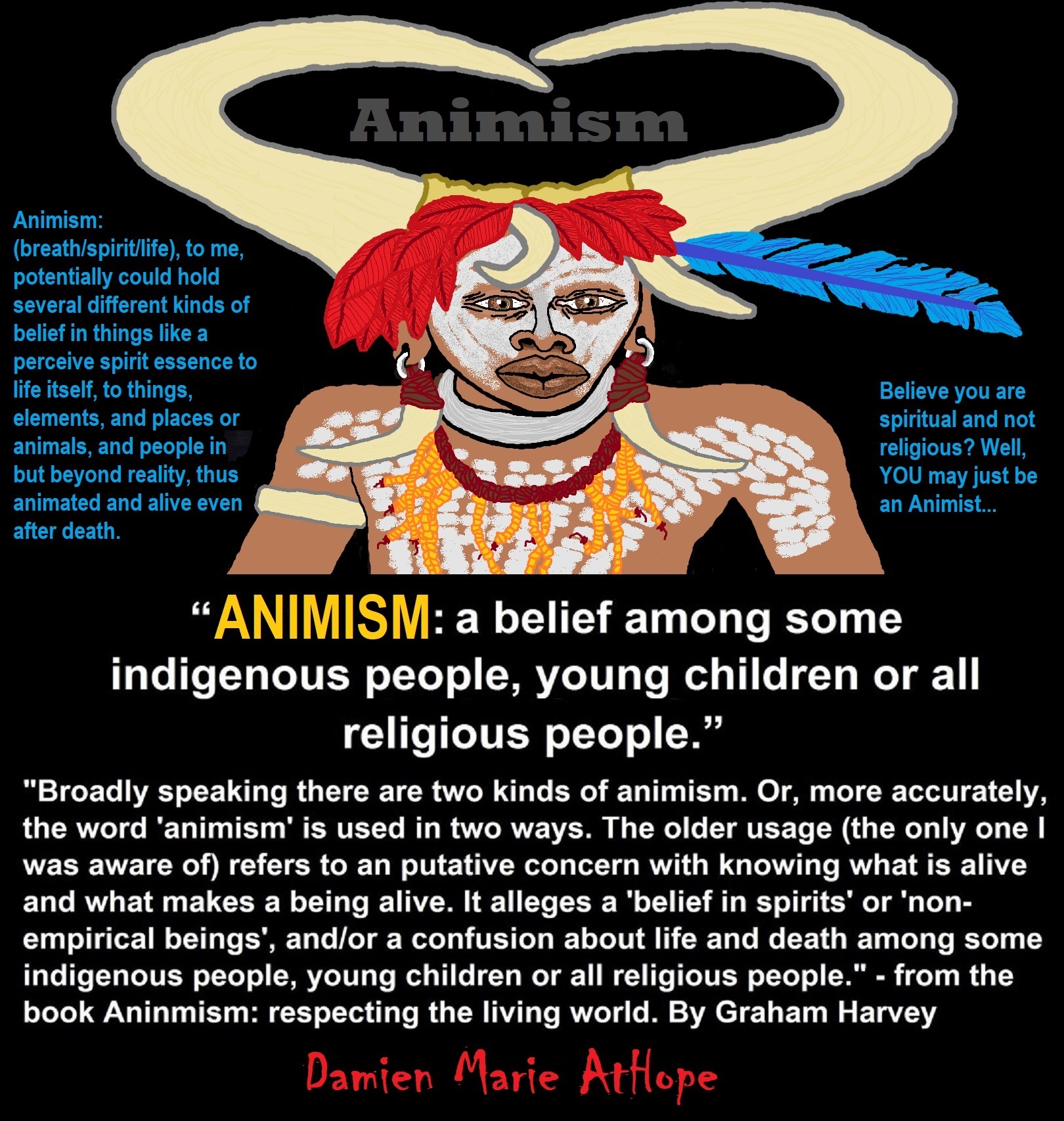
Animism: Respecting the Living World by Graham Harvey
“How have human cultures engaged with and thought about animals, plants, rocks, clouds, and other elements in their natural surroundings? Do animals and other natural objects have a spirit or soul? What is their relationship to humans? In this new study, Graham Harvey explores current and past animistic beliefs and practices of Native Americans, Maori, Aboriginal Australians, and eco-pagans. He considers the varieties of animism found in these cultures as well as their shared desire to live respectfully within larger natural communities. Drawing on his extensive casework, Harvey also considers the linguistic, performative, ecological, and activist implications of these different animisms.” ref
Animism: a belief among some indigenous people, young children, or all religious people: LINK


My thoughts on Religion Evolution with external links for more info:
- (Pre-Animism Africa mainly, but also Europe, and Asia at least 300,000 years ago), (Pre-Animism – Oxford Dictionaries)
- (Animism Africa around 100,000 years ago), (Animism – Britannica.com)
- (Totemism Europe around 50,000 years ago), (Totemism – Anthropology)
- (Shamanism Siberia around 30,000 years ago), (Shamanism – Britannica.com)
- (Paganism Turkey around 12,000 years ago), (Paganism – BBC Religion)
- (Progressed Organized Religion “Institutional Religion” Egypt around 5,000 years ago), (Ancient Egyptian Religion – Britannica.com)
- (CURRENT “World” RELIGIONS after 4,000 years ago) (Origin of Major Religions – Sacred Texts)
- (Early Atheistic Doubting at least by 2,600 years ago) (History of Atheism – Wikipedia)
“Religion is an Evolved Product” and Yes, Religion is Like Fear Given Wings…
Atheists talk about gods and religions for the same reason doctors talk about cancer, they are looking for a cure, or a firefighter talks about fires because they burn people and they care to stop them. We atheists too often feel a need to help the victims of mental slavery, held in the bondage that is the false beliefs of gods and the conspiracy theories of reality found in religions.
Understanding Religion Evolution:
- Pre-Animism (at least 300,000 years ago)
- Animism (Africa: 100,000 years ago)
- Totemism (Europe: 50,000 years ago)
- Shamanism (Siberia: 30,000 years ago)
- Paganism (Turkey: 12,000 years ago)
- Progressed organized religion (Egypt: 5,000 years ago), (Egypt, the First Dynasty 5,150 years ago)
- CURRENT “World” RELIGIONS (after 4,000 years ago)
- Early Atheistic Doubting (at least by 2,600 years ago)
“An Archaeological/Anthropological Understanding of Religion Evolution”
It seems ancient peoples had to survived amazing threats in a “dangerous universe (by superstition perceived as good and evil),” and human “immorality or imperfection of the soul” which was thought to affect the still living, leading to ancestor worship. This ancestor worship presumably led to the belief in supernatural beings, and then some of these were turned into the belief in gods. This feeble myth called gods were just a human conceived “made from nothing into something over and over, changing, again and again, taking on more as they evolve, all the while they are thought to be special,” but it is just supernatural animistic spirit-belief perceived as sacred.
Quick Evolution of Religion?
Pre-Animism (at least 300,000 years ago) pre-religion is a beginning that evolves into later Animism. So, Religion as we think of it, to me, all starts in a general way with Animism (Africa: 100,000 years ago) (theoretical belief in supernatural powers/spirits), then this is physically expressed in or with Totemism (Europe: 50,000 years ago) (theoretical belief in mythical relationship with powers/spirits through a totem item), which then enlists a full-time specific person to do this worship and believed interacting Shamanism (Siberia/Russia: 30,000 years ago) (theoretical belief in access and influence with spirits through ritual), and then there is the further employment of myths and gods added to all the above giving you Paganism (Turkey: 12,000 years ago) (often a lot more nature-based than most current top world religions, thus hinting to their close link to more ancient religious thinking it stems from). My hypothesis is expressed with an explanation of the building of a theatrical house (modern religions development). Progressed organized religion (Egypt: 5,000 years ago) with CURRENT “World” RELIGIONS (after 4,000 years ago).
Historically, in large city-state societies (such as Egypt or Iraq) starting around 5,000 years ago culminated to make religion something kind of new, a sociocultural-governmental-religious monarchy, where all or at least many of the people of such large city-state societies seem familiar with and committed to the existence of “religion” as the integrated life identity package of control dynamics with a fixed closed magical doctrine, but this juggernaut integrated religion identity package of Dogmatic-Propaganda certainly did not exist or if developed to an extent it was highly limited in most smaller prehistoric societies as they seem to lack most of the strong control dynamics with a fixed closed magical doctrine (magical beliefs could be at times be added or removed). Many people just want to see developed religious dynamics everywhere even if it is not. Instead, all that is found is largely fragments until the domestication of religion.
Religions, as we think of them today, are a new fad, even if they go back to around 6,000 years in the timeline of human existence, this amounts to almost nothing when seen in the long slow evolution of religion at least around 70,000 years ago with one of the oldest ritual worship. Stone Snake of South Africa: “first human worship” 70,000 years ago. This message of how religion and gods among them are clearly a man-made thing that was developed slowly as it was invented and then implemented peace by peace discrediting them all. Which seems to be a simple point some are just not grasping how devastating to any claims of truth when we can see the lie clearly in the archeological sites.
I wish people fought as hard for the actual values as they fight for the group/clan names political or otherwise they think support values. Every amount spent on war is theft to children in need of food or the homeless kept from shelter.
Here are several of my blog posts on history:
- To Find Truth You Must First Look
- (Magdalenian/Iberomaurusian) Connections to the First Paganists of the early Neolithic Near East Dating from around 17,000 to 12,000 Years Ago
- Natufians: an Ancient People at the Origins of Agriculture and Sedentary Life
- Possible Clan Leader/Special “MALE” Ancestor Totem Poles At Least 13,500 years ago?
- Jewish People with DNA at least 13,200 years old, Judaism, and the Origins of Some of its Ideas
- Baltic Reindeer Hunters: Swiderian, Lyngby, Ahrensburgian, and Krasnosillya cultures 12,020 to 11,020 years ago are evidence of powerful migratory waves during the last 13,000 years and a genetic link to Saami and the Finno-Ugric peoples.
- The Rise of Inequality: patriarchy and state hierarchy inequality
- Fertile Crescent 12,500 – 9,500 Years Ago: fertility and death cult belief system?
- 12,400 – 11,700 Years Ago – Kortik Tepe (Turkey) Pre/early-Agriculture Cultic Ritualism
- Ritualistic Bird Symbolism at Gobekli Tepe and its “Ancestor Cult”
- Male-Homosexual (female-like) / Trans-woman (female) Seated Figurine from Gobekli Tepe
- Could a 12,000-year-old Bull Geoglyph at Göbekli Tepe relate to older Bull and Female Art 25,000 years ago and Later Goddess and the Bull cults like Catal Huyuk?
- Sedentism and the Creation of goddesses around 12,000 years ago as well as male gods after 7,000 years ago.
- Alcohol, where Agriculture and Religion Become one? Such as Gobekli Tepe’s Ritualistic use of Grain as Food and Ritual Drink
- Neolithic Ritual Sites with T-Pillars and other Cultic Pillars
- Paganism: Goddesses around 12,000 years ago then Male Gods after 7,000 years ago
- First Patriarchy: Split of Women’s Status around 12,000 years ago & First Hierarchy: fall of Women’s Status around 5,000 years ago.
- Natufians: an Ancient People at the Origins of Agriculture and Sedentary Life
- J DNA and the Spread of Agricultural Religion (paganism)
- Paganism: an approximately 12,000-year-old belief system
- Paganism 12,000 years old: related to “Anarchism and Socialism” (Pre-Capitalism)
- Shaman burial in Israel 12,000 years ago and the Shamanism Phenomena
- Need to Mythicized: gods and goddesses
- 12,000 – 7,000 Years Ago – Paleo-Indian Culture (The Americas)
- 12,000 – 2,000 Years Ago – Indigenous-Scandinavians (Nordic)
- Norse did not wear helmets with horns?
- Pre-Pottery Neolithic Skull Cult around 11,500 to 8,400 Years Ago?
- 10,400 – 10,100 Years Ago, in Turkey the Nevail Cori Religious Settlement
- 9,000-6,500 Years Old Submerged Pre-Pottery/Pottery Neolithic Ritual Settlements off Israel’s Coast
- Catal Huyuk “first religious designed city” around 9,500 to 7,700 years ago (Turkey)
- Cultic Hunting at Catal Huyuk “first religious designed city”
- Special Items and Art as well as Special Elite Burials at Catal Huyuk
- New Rituals and Violence with the appearance of Pottery and People?
- Haplogroup N and its related Uralic Languages and Cultures
- Ainu people, Sámi people, Native Americans, the Ancient North Eurasians, and Paganistic-Shamanism with Totemism
- Ideas, Technology and People from Turkey, Europe, to China and Back again 9,000 to 5,000 years ago?
- First Pottery of Europe and the Related Cultures
- 9,000 years old Neolithic Artifacts Judean Desert and Hills Israel
- 9,000-7,000 years-old Sex and Death Rituals: Cult Sites in Israel, Jordan, and the Sinai
- 9,000-8500 year old Horned Female shaman Bad Dürrenberg Germany
- Neolithic Jewelry and the Spread of Farming in Europe Emerging out of West Turkey
- 8,600-year-old Tortoise Shells in Neolithic graves in central China have Early Writing and Shamanism
- Swing of the Mace: the rise of Elite, Forced Authority, and Inequality begin to Emerge 8,500 years ago?
- Migrations and Changing Europeans Beginning around 8,000 Years Ago
- My “Steppe-Anatolian-Kurgan hypothesis” 8,000/7,000 years ago
- Around 8,000-year-old Shared Idea of the Mistress of Animals, “Ritual” Motif
- Pre-Columbian Red-Paint (red ochre) Maritime Archaic Culture 8,000-3,000 years ago
- 7,522-6,522 years ago Linear Pottery culture which I think relates to Arcane Capitalism’s origins
- Arcane Capitalism: Primitive socialism, Primitive capital, Private ownership, Means of production, Market capitalism, Class discrimination, and Petite bourgeoisie (smaller capitalists)
- 7,500-4,750 years old Ritualistic Cucuteni-Trypillian culture of Moldova, Romania, and Ukraine
- Roots of a changing early society 7,200-6,700 years ago Jordan and Israel
- Agriculture religion (Paganism) with farming reached Britain between about 7,000 to 6,500 or so years ago and seemingly expressed in things like Western Europe’s Long Barrows
- My Thoughts on Possible Migrations of “R” DNA and Proto-Indo-European?
- “Millet” Spreading from China 7,022 years ago to Europe and related Language may have Spread with it leading to Proto-Indo-European
- Proto-Indo-European (PIE), ancestor of Indo-European languages: DNA, Society, Language, and Mythology
- The Dnieper–Donets culture and Asian varieties of Millet from China to the Black Sea region of Europe by 7,022 years ago
- Kurgan 6,000 years ago/dolmens 7,000 years ago: funeral, ritual, and other?
- 7,020 to 6,020-year-old Proto-Indo-European Homeland of Urheimat or proposed home of their Language and Religion
- Ancient Megaliths: Kurgan, Ziggurat, Pyramid, Menhir, Trilithon, Dolman, Kromlech, and Kromlech of Trilithons
- The Mytheme of Ancient North Eurasian Sacred-Dog belief and similar motifs are found in Indo-European, Native American, and Siberian comparative mythology
- Elite Power Accumulation: Ancient Trade, Tokens, Writing, Wealth, Merchants, and Priest-Kings
- Sacred Mounds, Mountains, Kurgans, and Pyramids may hold deep connections?
- Between 7,000-5,000 Years ago, rise of unequal hierarchy elite, leading to a “birth of the State” or worship of power, strong new sexism, oppression of non-elites, and the fall of Women’s equal status
- Paganism 7,000-5,000 years old: related to “Anarchism and Socialism” (Capitalism) (World War 0) Elite & their slaves
- Hell and Underworld mythologies starting maybe as far back as 7,000 to 5,000 years ago with the Proto-Indo-Europeans?
- The First Expression of the Male God around 7,000 years ago?
- White (light complexion skin) Bigotry and Sexism started 7,000 years ago?
- Around 7,000-year-old Shared Idea of the Divine Bird (Tutelary and/or Trickster spirit/deity), “Ritual” Motif
- Nekhbet an Ancient Egyptian Vulture Goddess and Tutelary Deity
- 6,720 to 4,920 years old Ritualistic Hongshan Culture of Inner Mongolia with 5,000-year-old Pyramid Mounds and Temples
- First proto-king in the Balkans, Varna culture around 6,500 years ago?
- 6,500–5,800 years ago in Israel Late Chalcolithic (Copper Age) Period in the Southern Levant Seems to Express Northern Levant Migrations, Cultural and Religious Transfer
- KING OF BEASTS: Master of Animals “Ritual” Motif, around 6,000 years old or older…
- Around 6000-year-old Shared Idea of the Solid Wheel & the Spoked Wheel-Shaped Ritual Motif
- “The Ghassulian Star,” a mysterious 6,000-year-old mural from Jordan; a Proto-Star of Ishtar, Star of Inanna or Star of Venus?
- Religious/Ritual Ideas, including goddesses and gods as well as ritual mounds or pyramids from Northeastern Asia at least 6,000 years old, seemingly filtering to Iran, Iraq, the Mediterranean, Europe, Egypt, and the Americas?
- Maykop (5,720–5,020 years ago) Caucasus region Bronze Age culture-related to Copper Age farmers from the south, influenced by the Ubaid period and Leyla-Tepe culture, as well as influencing the Kura-Araxes culture
- 5-600-year-old Tomb, Mummy, and First Bearded Male Figurine in a Grave
- Kura-Araxes Cultural 5,520 to 4,470 years old DNA traces to the Canaanites, Arabs, and Jews
- Minoan/Cretan (Keftiu) Civilization and Religion around 5,520 to 3,120 years ago
- Evolution Of Science at least by 5,500 years ago
- 5,500 Years old birth of the State, the rise of Hierarchy, and the fall of Women’s status
- “Jiroft culture” 5,100 – 4,200 years ago and the History of Iran
- Stonehenge: Paganistic Burial and Astrological Ritual Complex, England (5,100-3,600 years ago)
- Around 5,000-year-old Shared Idea of the “Tree of Life” Ritual Motif
- Complex rituals for elite, seen from China to Egypt, at least by 5,000 years ago
- Around 5,000 years ago: “Birth of the State” where Religion gets Military Power and Influence
- The Center of the World “Axis Mundi” and/or “Sacred Mountains” Mythology Could Relate to the Altai Mountains, Heart of the Steppe
- Progressed organized religion starts, an approximately 5,000-year-old belief system
- China’s Civilization between 5,000-3,000 years ago, was a time of war and class struggle, violent transition from free clans to a Slave or Elite society
- Origin of Logics is Naturalistic Observation at least by around 5,000 years ago.
- Paganism 5,000 years old: progressed organized religion and the state: related to “Anarchism and Socialism” (Kings and the Rise of the State)
- Ziggurats (multi-platform temples: 4,900 years old) to Pyramids (multi-platform tombs: 4,700 years old)
- Did a 4,520–4,420-year-old Volcano In Turkey Inspire the Bible God?
- Finland’s Horned Shaman and Pre-Horned-God at least 4,500 years ago?
- 4,000-year-Old Dolmens in Israel: A Connected Dolmen Religious Phenomenon?
- Creation myths: From chaos, Ex nihilo, Earth-diver, Emergence, World egg, and World parent
- Bronze Age “Ritual” connections of the Bell Beaker culture with the Corded Ware/Single Grave culture, which were related to the Yamnaya culture and Proto-Indo-European Languages/Religions
- Low Gods (Earth/ Tutelary deity), High Gods (Sky/Supreme deity), and Moralistic Gods (Deity enforcement/divine order)
- The exchange of people, ideas, and material-culture including, to me, the new god (Sky Father) and goddess (Earth Mother) religion between the Cucuteni-Trypillians and others which is then spread far and wide
- Koryaks: Indigenous People of the Russian Far East and Big Raven myths also found in Tlingit, Haida, Tsimshian, and other Indigenous People of North America
- 42 Principles Of Maat (Egyptian Goddess of the justice) around 4,400 years ago, 2000 Years Before Ten Commandments
- “Happy Easter” Well Happy Eostre/Ishter
- 4,320-3,820 years old “Shimao” (North China) site with Totemistic-Shamanistic Paganism and a Stepped Pyramid
- 4,250 to 3,400 Year old Stonehenge from Russia: Arkaim?
- 4,100-year-old beaker with medicinal & flowering plants in a grave of a woman in Scotland
- Early European Farmer ancestry, Kelif el Boroud people with the Cardial Ware culture, and the Bell Beaker culture Paganists too, spread into North Africa, then to the Canary Islands off West Africa
- Flood Accounts: Gilgamesh epic (4,100 years ago) Noah in Genesis (2,600 years ago)
- Paganism 4,000 years old: related to “Anarchism and Socialism” (First Moralistic gods, then the Origin time of Monotheism)
- When was the beginning: TIMELINE OF CURRENT RELIGIONS, which start around 4,000 years ago.
- Early Religions Thought to Express Proto-Monotheistic Systems around 4,000 years ago
- Kultepe? An archaeological site with a 4,000 years old women’s rights document.
- Single God Religions (Monotheism) = “Man-o-theism” started around 4,000 years ago with the Great Sky Spirit/God Tiān (天)?
- Confucianism’s Tiān (Shangdi god 4,000 years old): Supernaturalism, Pantheism or Theism?
- Yes, Your Male God is Ridiculous
- Mythology, a Lunar Deity is a Goddess or God of the Moon
- Sacred Land, Hills, and Mountains: Sami Mythology (Paganistic Shamanism)
- Horse Worship/Sacrifice: mythical union of Ruling Elite/Kingship and the Horse
- The Amorite/Amurru people’s God Amurru “Lord of the Steppe”, relates to the Origins of the Bible God?
- Bronze Age Exotic Trade Routes Spread Quite Far as well as Spread Religious Ideas with Them
- Sami and the Northern Indigenous Peoples Landscape, Language, and its Connection to Religion
- Prototype of Ancient Analemmatic Sundials around 3,900-3,150 years ago and a Possible Solar Connection to gods?
- Judaism is around 3,450 or 3,250 years old. (“Paleo-Hebrew” 3,000 years ago and Torah 2,500 years ago)
- The Weakening of Ancient Trade and the Strengthening of Religions around 3000 years ago?
- Are you aware that there are religions that worship women gods, explain now religion tears women down?
- Animistic, Totemistic, and Paganistic Superstition Origins of bible god and the bible’s Religion.
- Myths and Folklore: “Trickster gods and goddesses”
- Jews, Judaism, and the Origins of Some of its Ideas
- An Old Branch of Religion Still Giving Fruit: Sacred Trees
- Dating the BIBLE: naming names and telling times (written less than 3,000 years ago, provable to 2,200 years ago)
- Did a Volcano Inspire the bible god?
- Dené–Yeniseian language, Old Copper Complex, and Pre-Columbian Mound Builders?
- No “dinosaurs and humans didn’t exist together just because some think they are in the bible itself”
- Sacred Shit and Sacred Animals?
- Everyone Killed in the Bible Flood? “Nephilim” (giants)?
- Hey, Damien dude, I have a question for you regarding “the bible” Exodus.
- Archaeology Disproves the Bible
- Bible Battle, Just More, Bible Babble
- The Jericho Conquest lie?
- Canaanites and Israelites?
- Accurate Account on how did Christianity Began?
- Let’s talk about Christianity.
- So the 10 commandments isn’t anything to go by either right?
- Misinformed christian
- Debunking Jesus?
- Paulism vs Jesus
- Ok, you seem confused so let’s talk about Buddhism.
- Unacknowledged Buddhism: Gods, Savior, Demons, Rebirth, Heavens, Hells, and Terrorism
- His Foolishness The Dalai Lama
- Yin and Yang is sexist with an ORIGIN around 2,300 years ago?
- I Believe Archaeology, not Myths & Why Not, as the Religious Myths Already Violate Reason!
- Archaeological, Scientific, & Philosophic evidence shows the god myth is man-made nonsense.
- Aquatic Ape Theory/Hypothesis? As Always, Just Pseudoscience.
- Ancient Aliens Conspiracy Theorists are Pseudohistorians
- The Pseudohistoric and Pseudoscientific claims about “Bakoni Ruins” of South Africa
- Why do people think Religion is much more than supernaturalism and superstitionism?
- Religion is an Evolved Product
- Was the Value of Ancient Women Different?
- 1000 to 1100 CE, human sacrifice Cahokia Mounds a pre-Columbian Native American site
- Feminist atheists as far back as the 1800s?
- Promoting Religion as Real is Mentally Harmful to a Flourishing Humanity
- Screw All Religions and Their Toxic lies, they are all fraud
- Forget Religions’ Unfounded Myths, I Have Substantiated “Archaeology Facts.”
- Religion Dispersal throughout the World
- I Hate Religion Just as I Hate all Pseudoscience
- Exposing Scientology, Eckankar, Wicca and Other Nonsense?
- Main deity or religious belief systems
- Quit Trying to Invent Your God From the Scraps of Science.
- Archaeological, Scientific, & Philosophic evidence shows the god myth is man-made nonsense.
- Ancient Alien Conspiracy Theorists: Misunderstanding, Rhetoric, Misinformation, Fabrications, and Lies
- Misinformation, Distortion, and Pseudoscience in Talking with a Christian Creationist
- Judging the Lack of Goodness in Gods, Even the Norse God Odin
- Challenging the Belief in God-like Aliens and Gods in General
- A Challenge to Christian use of Torture Devices?
- Yes, Hinduism is a Religion
- Trump is One of the Most Reactionary Forces of Far-right Christian Extremism
- Was the Bull Head a Symbol of God? Yes!
- Primate Death Rituals
- Christian – “God and Christianity are objectively true”
- Australopithecus afarensis Death Ritual?
- You Claim Global Warming is a Hoax?
- Doubter of Science and Defamer of Atheists?
- I think that sounds like the Bible?
- History of the Antifa (“anti-fascist”) Movements
- Indianapolis Anti-Blasphemy Laws #Free Soheil Rally
- Damien, you repeat the golden rule in so many forms then you say religion is dogmatic?
- Science is a Trustable Methodology whereas Faith is not Trustable at all!
- Was I ever a believer, before I was an atheist?
- Atheists rise in reason
- Mistrust of science?
- Open to Talking About the Definition of ‘God’? But first, we address Faith.
- ‘United Monarchy’ full of splendor and power – Saul, David, and Solomon? Most likely not.
- Is there EXODUS ARCHAEOLOGY? The short answer is “no.”
- Lacking Proof of Bigfoots, Unicorns, and Gods is Just a Lack of Research?
- Religion and Politics: Faith Beliefs vs. Rational Thinking
- Hammer of Truth that lying pig RELIGION: challenged by an archaeologist
- “The Hammer of Truth” -ontology question- What do You Mean by That?
- Navigation of a bad argument: Ad Hominem vs. Attack
- Why is it Often Claimed that Gods have a Gender?
- Why are basically all monotheistic religions ones that have a male god?
- Shifting through the Claims in support of Faith
- Dear Mr. AtHope, The 20th Century is an Indictment of Secularism and a Failed Atheist Century
- An Understanding of the Worldwide Statistics and Dynamics of Terrorist Incidents and Suicide Attacks
- Intoxication and Evolution? Addressing and Assessing the “Stoned Ape” or “Drunken Monkey” Theories as Catalysts in Human Evolution
- Sacred Menstrual cloth? Inanna’s knot, Isis knot, and maybe Ma’at’s feather?
- Damien, why don’t the Hebrews accept the bible stories?
- Dealing with a Troll and Arguing Over Word Meaning
- Knowledge without Belief? Justified beliefs or disbeliefs worthy of Knowledge?
- Afrocentrism and African Religions
- Crecganford @crecganford offers history & stories of the people, places, gods, & culture
- Empiricism-Denier?
I am not an academic. I am a revolutionary that teaches in public, in places like social media, and in the streets. I am not a leader by some title given but from my commanding leadership style of simply to start teaching everywhere to everyone, all manner of positive education.


Animism as in that seen in Africa: 100,000 years ago: VIEDO
Animism as in that seen in Africa: 100,000 years ago Did Neanderthals teach us “Primal Religion (Pre-Animism/Animism?)” 120,000 Years Ago? Homo sapiens – is known to have reached the Levant between 120,000 and 90,000 years ago, but that exit from Africa evidently went extinct. 100,000 years ago, in Qafzeh, Israel, the oldest intentional burial had 15 African individuals covered in red ocher was from a group who visited and returned back to Africa. 100,000 to 74,000 years ago, at Border Cave in Africa, an intentional burial of an infant with red ochre and a shell ornament, which may have possible connections to the Africans buried in Qafzeh. Animism is approximately a 100,000-year-old belief system and believes in spirit-filled life and/or afterlife. If you believe like this, regardless of your faith, you are a hidden animist.
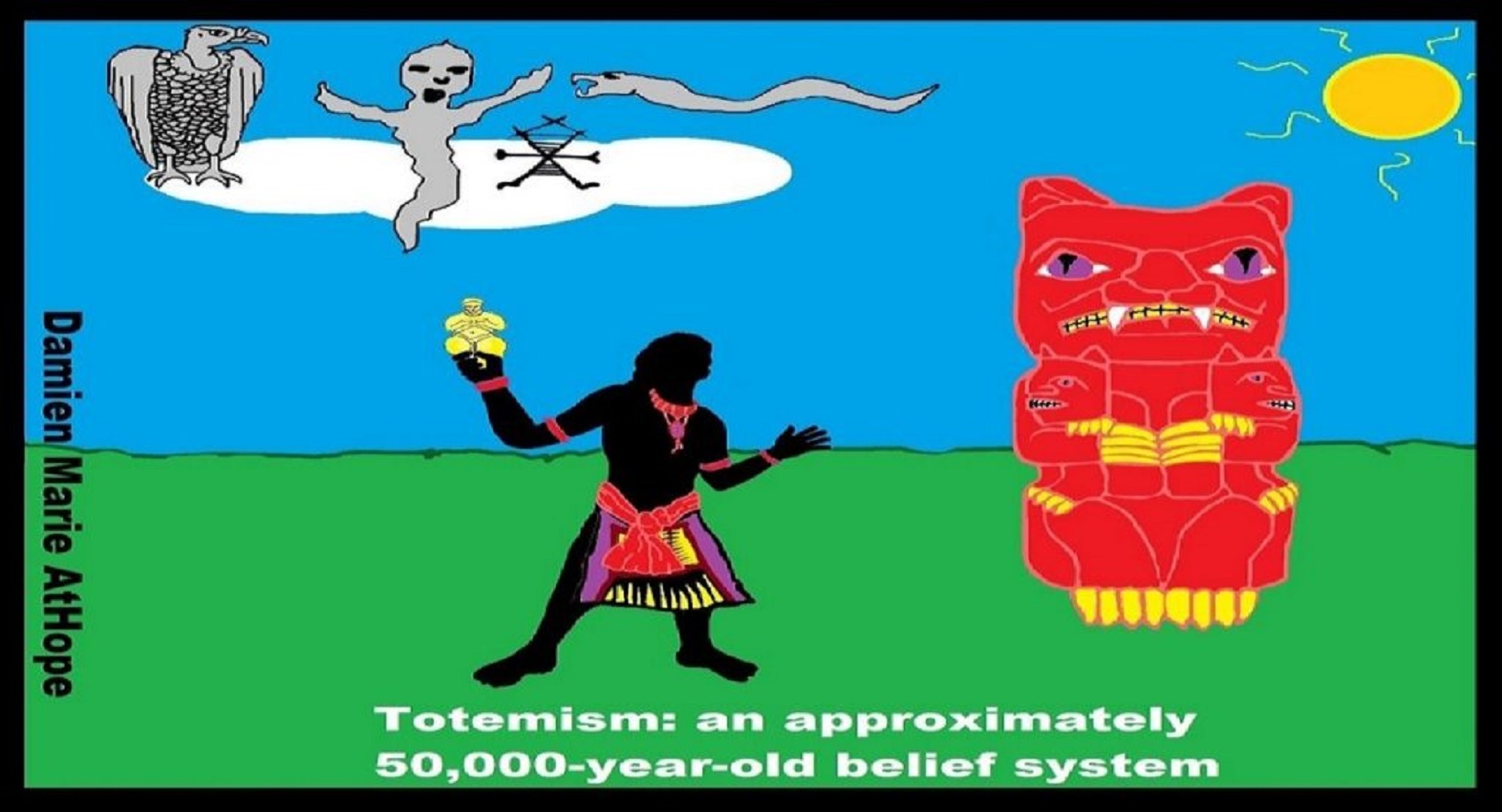
“Totemism” as first seen in Europe: 50,000 years ago: VIEDO
“Totemism” as first seen in Europe: 50,000 years ago, mainly the Aurignacian culture
*Pre-Aurignacian “Châtelperronian” (Western Europe, mainly Spain and France, possible transitional/cultural diffusion between Neanderthals and humans around 50,000-40,000 years ago) Archaic–Aurignacian/Proto-Aurignacian (Europe around 46,000-35,000)
*Aurignacian culture to me arose possibly from Châtelperronian diffusion between Neanderthals and humans and the European Bohunician culture in South-Central and East Europe dated at 48,000 years ago, thought to be related to Levant Emiran dated to around 50,000—40,000 years ago…
*Ahmarian culture in the Levant dated at 46,000-42,000 years ago and thought to be related to Levantine Emiran and younger European Aurignacian cultures which began spreading from the Middle East. Such as, in the likes of the Manot Cave, occupied from about 55,000 years ago to at least 30,000 years ago some of who moved toward Europe at least by 45,000 years. ref, ref *Aurignacian “classical/early to late” (Europe and other areas around 38,000 – 26,000 years ago)
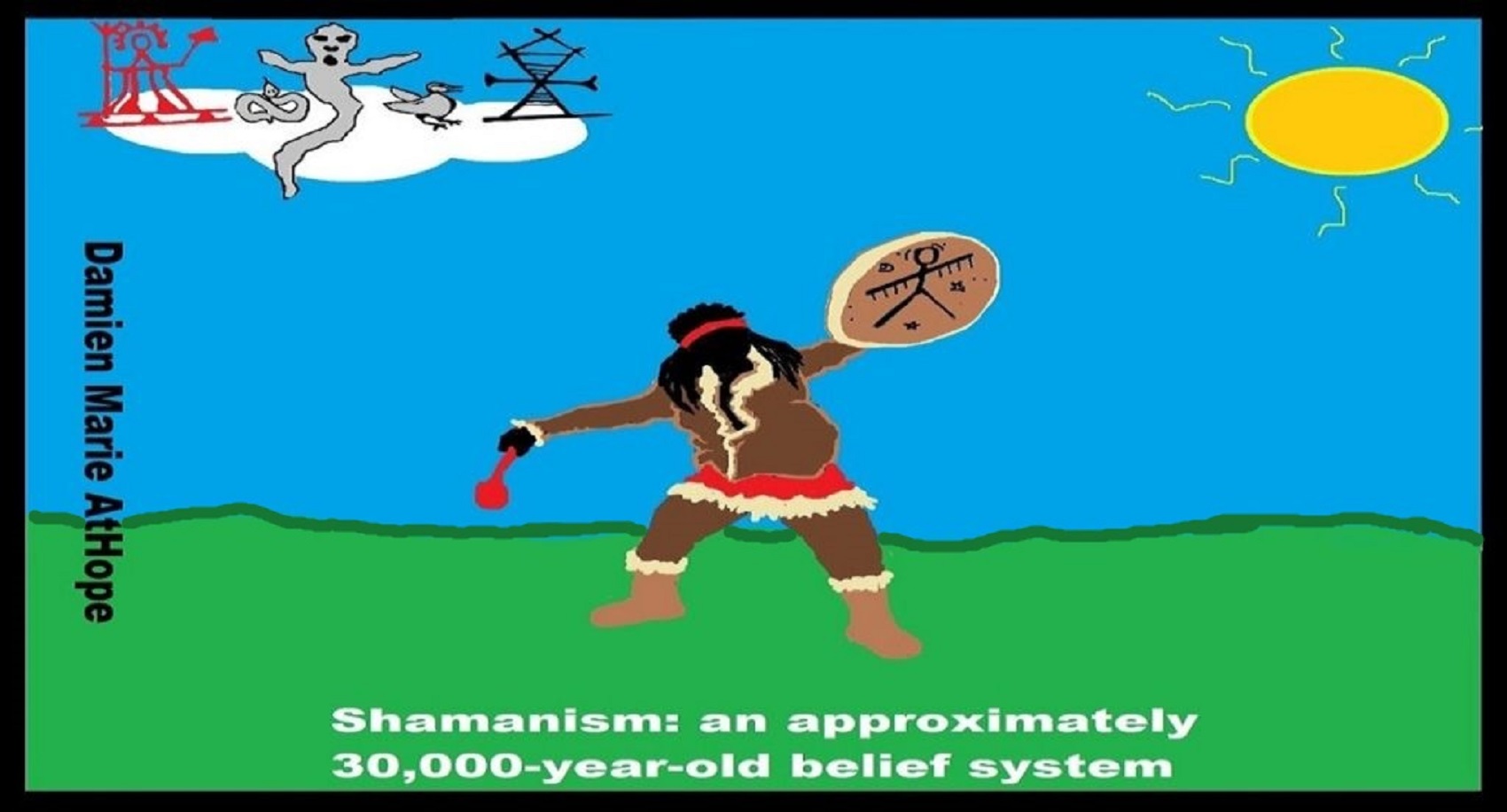
Shamanism (as seen in Siberia: 30,000 years ago): VIEDO
Shamanism (such as that seen in Siberia Gravettian culture: 30,000 years ago). Gravettian culture (34,000–24,000 years ago; Western Gravettian, mainly France, Spain, and Britain, as well as Eastern Gravettian in Central Europe and Russia. The eastern Gravettians, which include the Pavlovian culture). And, the Pavlovian culture (31,000 – 25,000 years ago such as in Austria and Poland). 31,000 – 20,000 years ago Oldest Shaman was Female, Buried with the Oldest Portrait Carving.

Paganism (Turkey: 12,000 years ago): VIEDO
Paganism (such as that seen in Turkey: 12,000 years ago). Gobekli Tepe: “first human-made temple” around 12,000 years ago. Sedentism and the Creation of goddesses around 12,000 years ago as well as male gods after 7,000 years ago. Pagan-Shaman burial in Israel 12,000 years ago and 12,000 – 10,000 years old Paganistic-Shamanistic Art in a Remote Cave in Egypt. Skull Cult around 11,500 to 8,400 Years Ago and Catal Huyuk “first religious designed city” around 10,000 years ago.
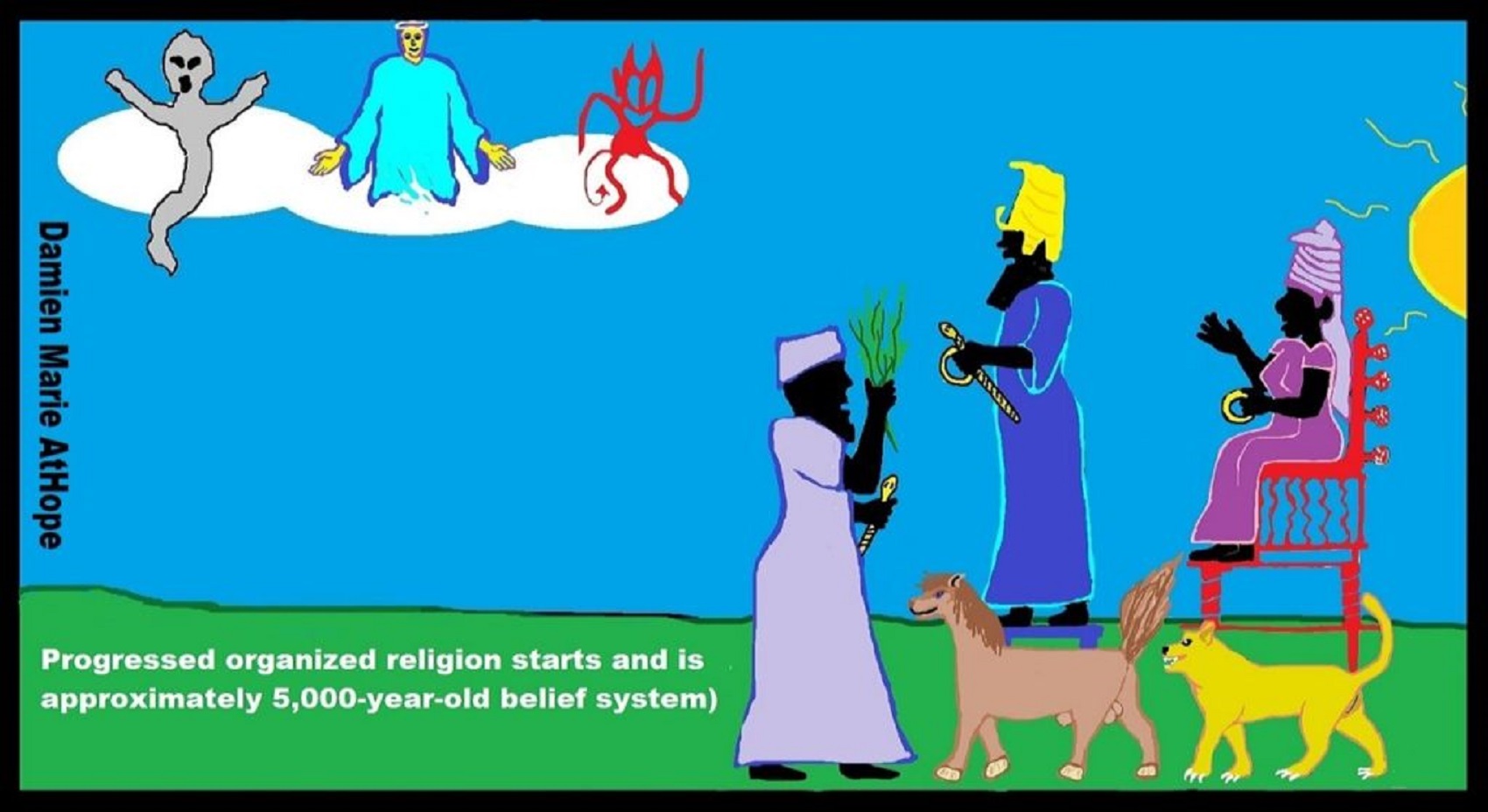
Animism, Totemism, Shamanism, Paganism & Progressed organized religion: VIEDO

Hinduism around 3,700 to 3,500 years old. ref
Judaism around 3,450 or 3,250 years old. (The first writing in the bible was “Paleo-Hebrew” dated to around 3,000 years ago Khirbet Qeiyafa is the site of an ancient fortress city overlooking the Elah Valley. And many believe the religious Jewish texts were completed around 2,500) ref, ref
Judaism is around 3,450 or 3,250 years old. (“Paleo-Hebrew” 3,000 years ago and Torah 2,500 years ago)
“Judaism is an Abrahamic, its roots as an organized religion in the Middle East during the Bronze Age. Some scholars argue that modern Judaism evolved from Yahwism, the religion of ancient Israel and Judah, by the late 6th century BCE, and is thus considered to be one of the oldest monotheistic religions.” ref
“Yahwism is the name given by modern scholars to the religion of ancient Israel, essentially polytheistic, with a plethora of gods and goddesses. Heading the pantheon was Yahweh, the national god of the Israelite kingdoms of Israel and Judah, with his consort, the goddess Asherah; below them were second-tier gods and goddesses such as Baal, Shamash, Yarikh, Mot, and Astarte, all of whom had their own priests and prophets and numbered royalty among their devotees, and a third and fourth tier of minor divine beings, including the mal’ak, the messengers of the higher gods, who in later times became the angels of Judaism, Christianity and Islam. Yahweh, however, was not the ‘original’ god of Israel “Isra-El”; it is El, the head of the Canaanite pantheon, whose name forms the basis of the name “Israel”, and none of the Old Testament patriarchs, the tribes of Israel, the Judges, or the earliest monarchs, have a Yahwistic theophoric name (i.e., one incorporating the name of Yahweh).” ref
“El is a Northwest Semitic word meaning “god” or “deity“, or referring (as a proper name) to any one of multiple major ancient Near Eastern deities. A rarer form, ‘ila, represents the predicate form in Old Akkadian and in Amorite. The word is derived from the Proto-Semitic *ʔil-, meaning “god”. Specific deities known as ‘El or ‘Il include the supreme god of the ancient Canaanite religion and the supreme god of East Semitic speakers in Mesopotamia’s Early Dynastic Period. ʼĒl is listed at the head of many pantheons. In some Canaanite and Ugaritic sources, ʼĒl played a role as father of the gods, of creation, or both. For example, in the Ugaritic texts, ʾil mlk is understood to mean “ʼĒl the King” but ʾil hd as “the god Hadad“. The Semitic root ʾlh (Arabic ʾilāh, Aramaic ʾAlāh, ʾElāh, Hebrew ʾelōah) may be ʾl with a parasitic h, and ʾl may be an abbreviated form of ʾlh. In Ugaritic the plural form meaning “gods” is ʾilhm, equivalent to Hebrew ʾelōhîm “powers”. In the Hebrew texts this word is interpreted as being semantically singular for “god” by biblical commentators. However the documentary hypothesis for the Old Testament (corresponds to the Jewish Torah) developed originally in the 1870s, identifies these that different authors – the Jahwist, Elohist, Deuteronomist, and the Priestly source – were responsible for editing stories from a polytheistic religion into those of a monotheistic religion. Inconsistencies that arise between monotheism and polytheism in the texts are reflective of this hypothesis.” ref
Jainism around 2,599 – 2,527 years old. ref
Confucianism around 2,600 – 2,551 years old. ref
Buddhism around 2,563/2,480 – 2,483/2,400 years old. ref
Christianity around 2,o00 years old. ref
Shinto around 1,305 years old. ref
Islam around 1407–1385 years old. ref
Religion Evolution by Archaeology and Anthropology: VIEDO



While hallucinogens are associated with shamanism, it is alcohol that is associated with paganism.
The Atheist-Humanist-Leftist Revolutionaries Shows in the prehistory series:
Show two: Pre-animism 300,000 years old and animism 100,000 years old: related to “Anarchism and Socialism”
Show tree: Totemism 50,000 years old: related to “Anarchism and Socialism”
Show four: Shamanism 30,000 years old: related to “Anarchism and Socialism”
Show five: Paganism 12,000 years old: related to “Anarchism and Socialism”
Show six: Emergence of hierarchy, sexism, slavery, and the new male god dominance: Paganism 7,000-5,000 years old: related to “Anarchism and Socialism” (Capitalism) (World War 0) Elite and their slaves!
Prehistory: related to “Anarchism and Socialism” the division of labor, power, rights, and recourses: VIDEO
Pre-animism 300,000 years old and animism 100,000 years old: related to “Anarchism and Socialism”: VIDEO
Totemism 50,000 years old: related to “Anarchism and Socialism”: VIDEO
Shamanism 30,000 years old: related to “Anarchism and Socialism”: VIDEO
Paganism 12,000 years old: related to “Anarchism and Socialism” (Pre-Capitalism): VIDEO
Paganism 7,000-5,000 years old: related to “Anarchism and Socialism” (Capitalism) (World War 0) Elite and their slaves: VIEDO
Paganism 5,000 years old: progressed organized religion and the state: related to “Anarchism and Socialism” (Kings and the Rise of the State): VIEDO
Paganism 4,000 years old: related to “Anarchism and Socialism” (First Moralistic gods, then the Origin time of Monotheism): VIEDO
I do not hate simply because I challenge and expose myths or lies any more than others being thought of as loving simply because of the protection and hiding from challenge their favored myths or lies.
The truth is best championed in the sunlight of challenge.
An archaeologist once said to me “Damien religion and culture are very different”
My response, So are you saying that was always that way, such as would you say Native Americans’ cultures are separate from their religions? And do you think it always was the way you believe?
I had said that religion was a cultural product. That is still how I see it and there are other archaeologists that think close to me as well. Gods too are the myths of cultures that did not understand science or the world around them, seeing magic/supernatural everywhere.
I personally think there is a goddess and not enough evidence to support a male god at Çatalhöyük but if there was both a male and female god and goddess then I know the kind of gods they were like Proto-Indo-European mythology.
This series idea was addressed in, Anarchist Teaching as Free Public Education or Free Education in the Public: VIDEO
Our 12 video series: Organized Oppression: Mesopotamian State Force and the Politics of power (9,000-4,000 years ago), is adapted from: The Complete and Concise History of the Sumerians and Early Bronze Age Mesopotamia (7000-2000 BC): https://www.youtube.com/watch?v=szFjxmY7jQA by “History with Cy“
Show #1: Mesopotamian State Force and the Politics of Power (Samarra, Halaf, Ubaid)
Show #2: Mesopotamian State Force and the Politics of Power
Show #3: Mesopotamian State Force and the Politics of Power (Uruk and the First Cities)
Show #4: Mesopotamian State Force and the Politics of Power (First Kings)
Show #5: Mesopotamian State Force and the Politics of Power (Early Dynastic Period)
Show #6: Mesopotamian State Force and the Politics of Power
Show #7: Mesopotamian State Force and the Politics of Power (Sargon and Akkadian Rule)
Show #9: Mesopotamian State Force and the Politics of Power (Gudea of Lagash and Utu-hegal)
Show #12: Mesopotamian State Force and the Politics of Power (Aftermath and Legacy of Sumer)

The “Atheist-Humanist-Leftist Revolutionaries”
Cory Johnston ☭ Ⓐ Atheist Leftist @Skepticallefty & I (Damien Marie AtHope) @AthopeMarie (my YouTube & related blog) are working jointly in atheist, antitheist, antireligionist, antifascist, anarchist, socialist, and humanist endeavors in our videos together, generally, every other Saturday.
Why Does Power Bring Responsibility?
Think, how often is it the powerless that start wars, oppress others, or commit genocide? So, I guess the question is to us all, to ask, how can power not carry responsibility in a humanity concept? I know I see the deep ethical responsibility that if there is power their must be a humanistic responsibility of ethical and empathic stewardship of that power. Will I be brave enough to be kind? Will I possess enough courage to be compassionate? Will my valor reach its height of empathy? I as everyone, earns our justified respect by our actions, that are good, ethical, just, protecting, and kind. Do I have enough self-respect to put my love for humanity’s flushing, over being brought down by some of its bad actors? May we all be the ones doing good actions in the world, to help human flourishing.
I create the world I want to live in, striving for flourishing. Which is not a place but a positive potential involvement and promotion; a life of humanist goal precision. To master oneself, also means mastering positive prosocial behaviors needed for human flourishing. I may have lost a god myth as an atheist, but I am happy to tell you, my friend, it is exactly because of that, leaving the mental terrorizer, god belief, that I truly regained my connected ethical as well as kind humanity.
Cory and I will talk about prehistory and theism, addressing the relevance to atheism, anarchism, and socialism.
At the same time as the rise of the male god, 7,000 years ago, there was also the very time there was the rise of violence, war, and clans to kingdoms, then empires, then states. It is all connected back to 7,000 years ago, and it moved across the world.
Cory Johnston: https://damienmarieathope.com/2021/04/cory-johnston-mind-of-a-skeptical-leftist/?v=32aec8db952d
The Mind of a Skeptical Leftist (YouTube)
Cory Johnston: Mind of a Skeptical Leftist @Skepticallefty
The Mind of a Skeptical Leftist By Cory Johnston: “Promoting critical thinking, social justice, and left-wing politics by covering current events and talking to a variety of people. Cory Johnston has been thoughtfully talking to people and attempting to promote critical thinking, social justice, and left-wing politics.” http://anchor.fm/skepticalleft
Cory needs our support. We rise by helping each other.
Cory Johnston ☭ Ⓐ @Skepticallefty Evidence-based atheist leftist (he/him) Producer, host, and co-host of 4 podcasts @skeptarchy @skpoliticspod and @AthopeMarie
Damien Marie AtHope (“At Hope”) Axiological Atheist, Anti-theist, Anti-religionist, Secular Humanist. Rationalist, Writer, Artist, Poet, Philosopher, Advocate, Activist, Psychology, and Armchair Archaeology/Anthropology/Historian.
Damien is interested in: Freedom, Liberty, Justice, Equality, Ethics, Humanism, Science, Atheism, Antiteism, Antireligionism, Ignosticism, Left-Libertarianism, Anarchism, Socialism, Mutualism, Axiology, Metaphysics, LGBTQI, Philosophy, Advocacy, Activism, Mental Health, Psychology, Archaeology, Social Work, Sexual Rights, Marriage Rights, Woman’s Rights, Gender Rights, Child Rights, Secular Rights, Race Equality, Ageism/Disability Equality, Etc. And a far-leftist, “Anarcho-Humanist.”
I am not a good fit in the atheist movement that is mostly pro-capitalist, I am anti-capitalist. Mostly pro-skeptic, I am a rationalist not valuing skepticism. Mostly pro-agnostic, I am anti-agnostic. Mostly limited to anti-Abrahamic religions, I am an anti-religionist.
To me, the “male god” seems to have either emerged or become prominent around 7,000 years ago, whereas the now favored monotheism “male god” is more like 4,000 years ago or so. To me, the “female goddess” seems to have either emerged or become prominent around 11,000-10,000 years ago or so, losing the majority of its once prominence around 2,000 years ago due largely to the now favored monotheism “male god” that grow in prominence after 4,000 years ago or so.
My Thought on the Evolution of Gods?
Animal protector deities from old totems/spirit animal beliefs come first to me, 13,000/12,000 years ago, then women as deities 11,000/10,000 years ago, then male gods around 7,000/8,000 years ago. Moralistic gods around 5,000/4,000 years ago, and monotheistic gods around 4,000/3,000 years ago.


Damien Marie AtHope (Said as “At” “Hope”)/(Autodidact Polymath but not good at math):
Axiological Atheist, Anti-theist, Anti-religionist, Secular Humanist, Rationalist, Writer, Artist, Jeweler, Poet, “autodidact” Philosopher, schooled in Psychology, and “autodidact” Armchair Archaeology/Anthropology/Pre-Historian (Knowledgeable in the range of: 1 million to 5,000/4,000 years ago). I am an anarchist socialist politically. Reasons for or Types of Atheism
My Website, My Blog, & Short-writing or Quotes, My YouTube, Twitter: @AthopeMarie, and My Email: damien.marie.athope@gmail.com





